Perennial flower beds offer endless possibilities for creating stunning garden displays that return year after year with minimal replanting. These enduring plants provide continuous color, texture, and fragrance while establishing the backbone of any well-designed landscape. From Mediterranean-inspired drought-tolerant schemes to lush cottage garden borders, perennial beds can be tailored to suit any style preference, climate condition, or maintenance level. The key to successful perennial garden design lies in understanding bloom times, color combinations, height variations, and seasonal interest. By carefully selecting plants that complement each other throughout the growing season, gardeners can create dynamic spaces that evolve and mature beautifully over time.
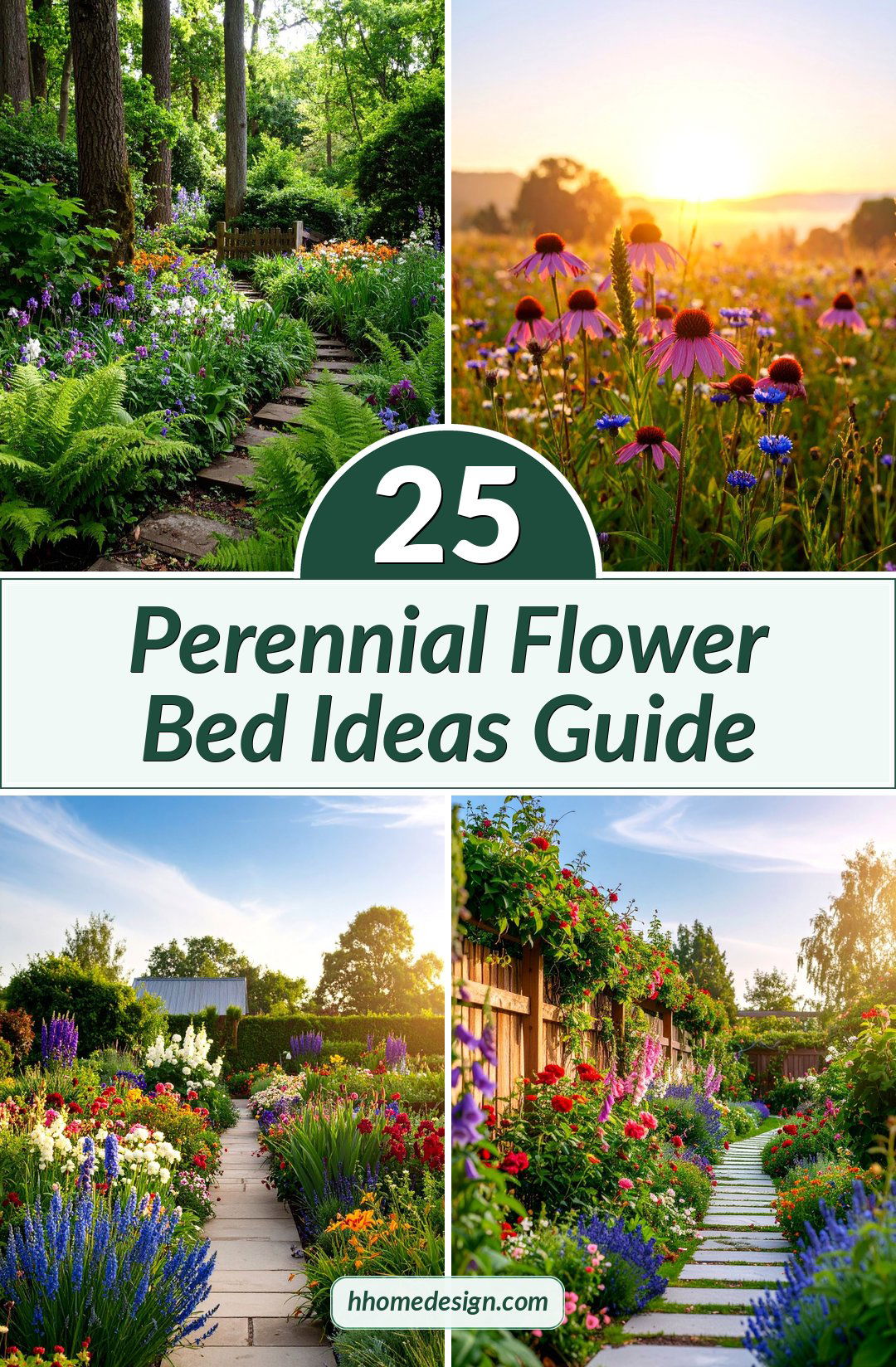
1. Mediterranean Drought-Tolerant Perennial Border
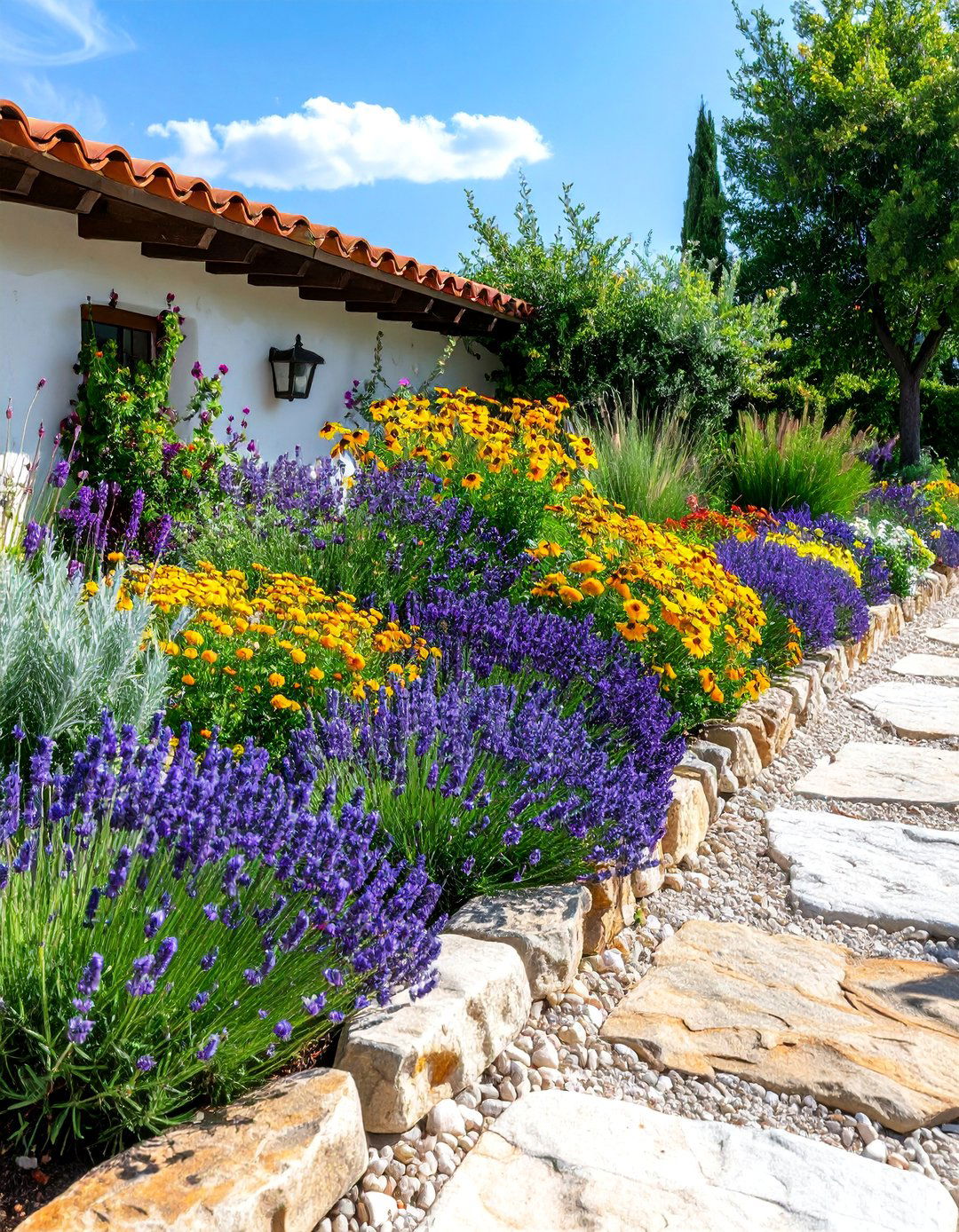
This sun-loving design captures the essence of coastal Mediterranean landscapes through carefully selected drought-resistant perennials. Lavender forms the fragrant foundation, paired with silvery artemisia, purple salvia, and bright yellow coreopsis. Ornamental grasses like fountain grass add movement and texture, while rock roses provide ground-level color. The design incorporates gravel pathways and natural stone elements to enhance drainage and create authentic Mediterranean ambiance. Rosemary and catmint contribute both culinary value and aromatic appeal. This low-maintenance border thrives in full sun with minimal watering once established, making it perfect for water-wise gardening approaches while delivering continuous color from spring through fall.
2. Pollinator Paradise Perennial Garden
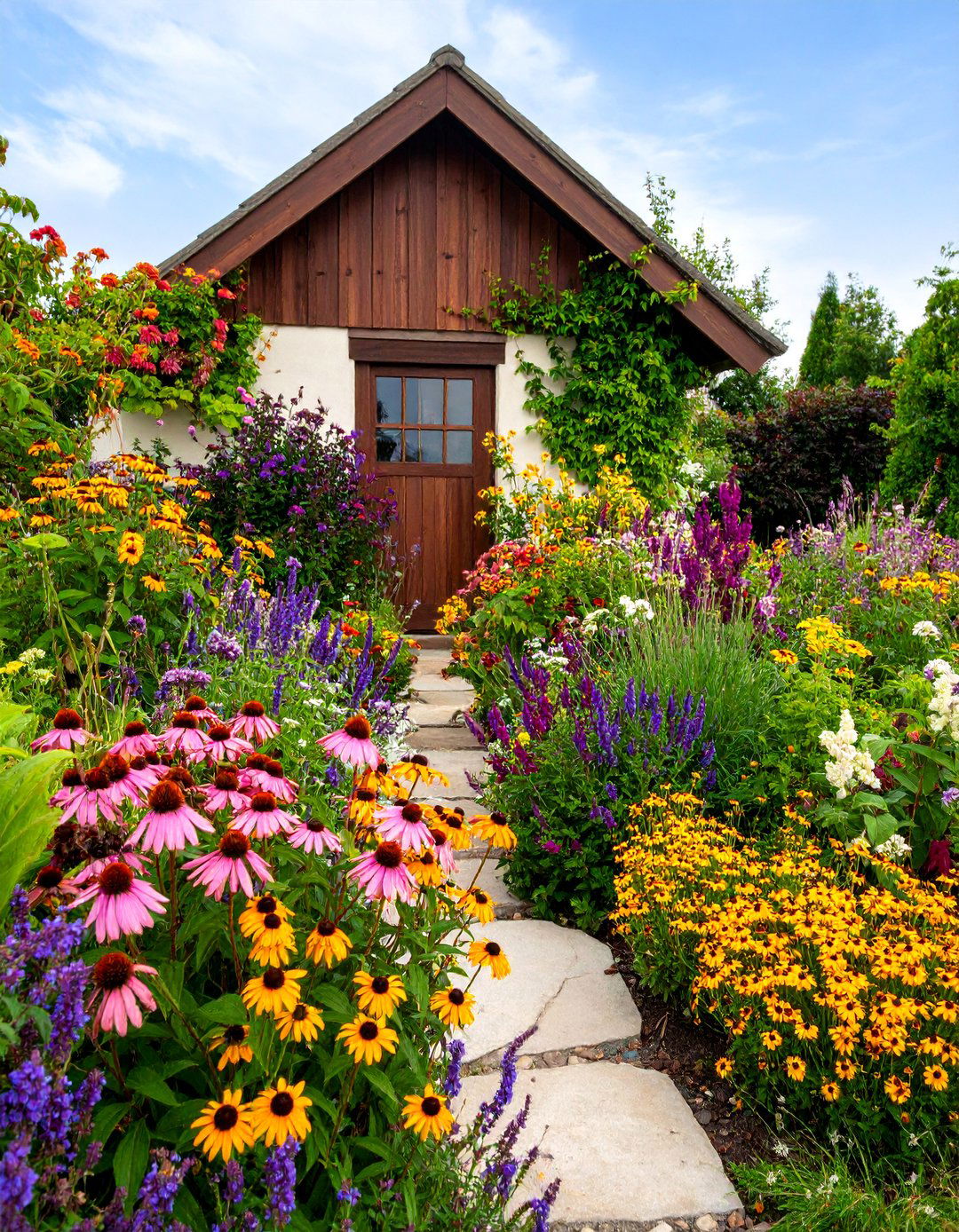
Create a vibrant ecosystem that supports bees, butterflies, and hummingbirds with this diverse pollinator-friendly design. Purple coneflowers anchor the display alongside native black-eyed Susans and bee balm in varying heights. Agastache provides long-blooming spikes that hummingbirds adore, while native asters extend late-season nectar sources. Milkweed serves as essential monarch butterfly habitat, complemented by colorful native phlox and wild bergamot. The design incorporates varying bloom times ensuring continuous food sources from early spring through late fall. Plant groupings are clustered for maximum visual impact and efficient foraging. Native ornamental grasses provide winter interest and nesting materials, while avoiding pesticides maintains this garden as a safe haven for beneficial insects and wildlife.
3. Moonlight Garden with White Perennials
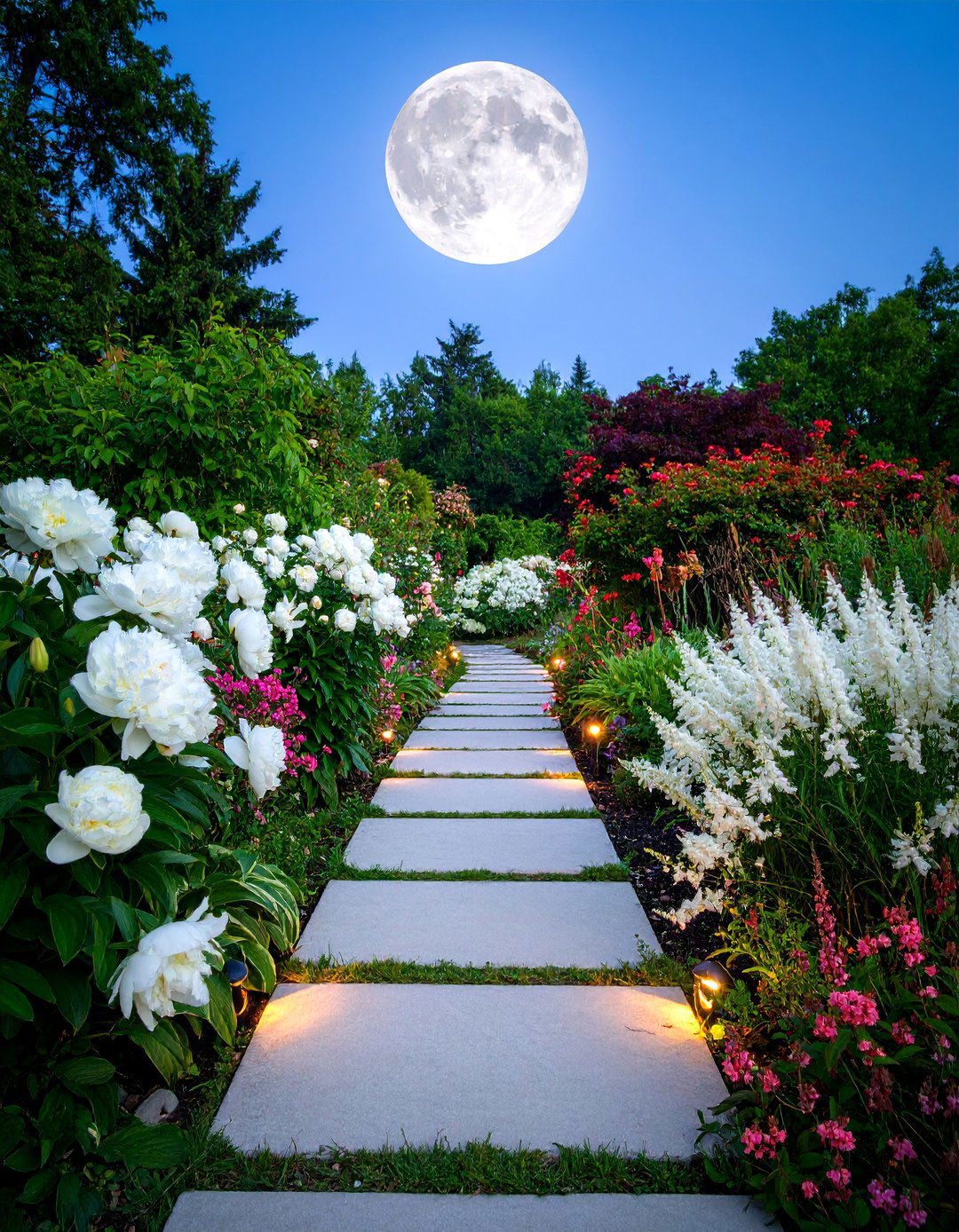
Transform evening hours into magical experiences with this enchanting white-themed perennial collection. Fragrant white peonies and Oriental lilies provide stunning focal points, while white astilbe creates delicate texture in shadier spots. Silver-leafed lamb's ear and artemisia reflect moonlight beautifully, creating luminous effects after dark. White phlox and sweet alyssum release intensified evening fragrances that enhance the sensory experience. Variegated hostas contribute bold foliage patterns visible in dim light, while white coneflowers and Shasta daisies maintain bright displays throughout summer. This design includes night-blooming plants that open at dusk, creating dynamic changes as day transitions to evening. Strategic lighting can enhance the ethereal glow of white flowers and silvery foliage.
4. English Cottage Garden Perennial Border
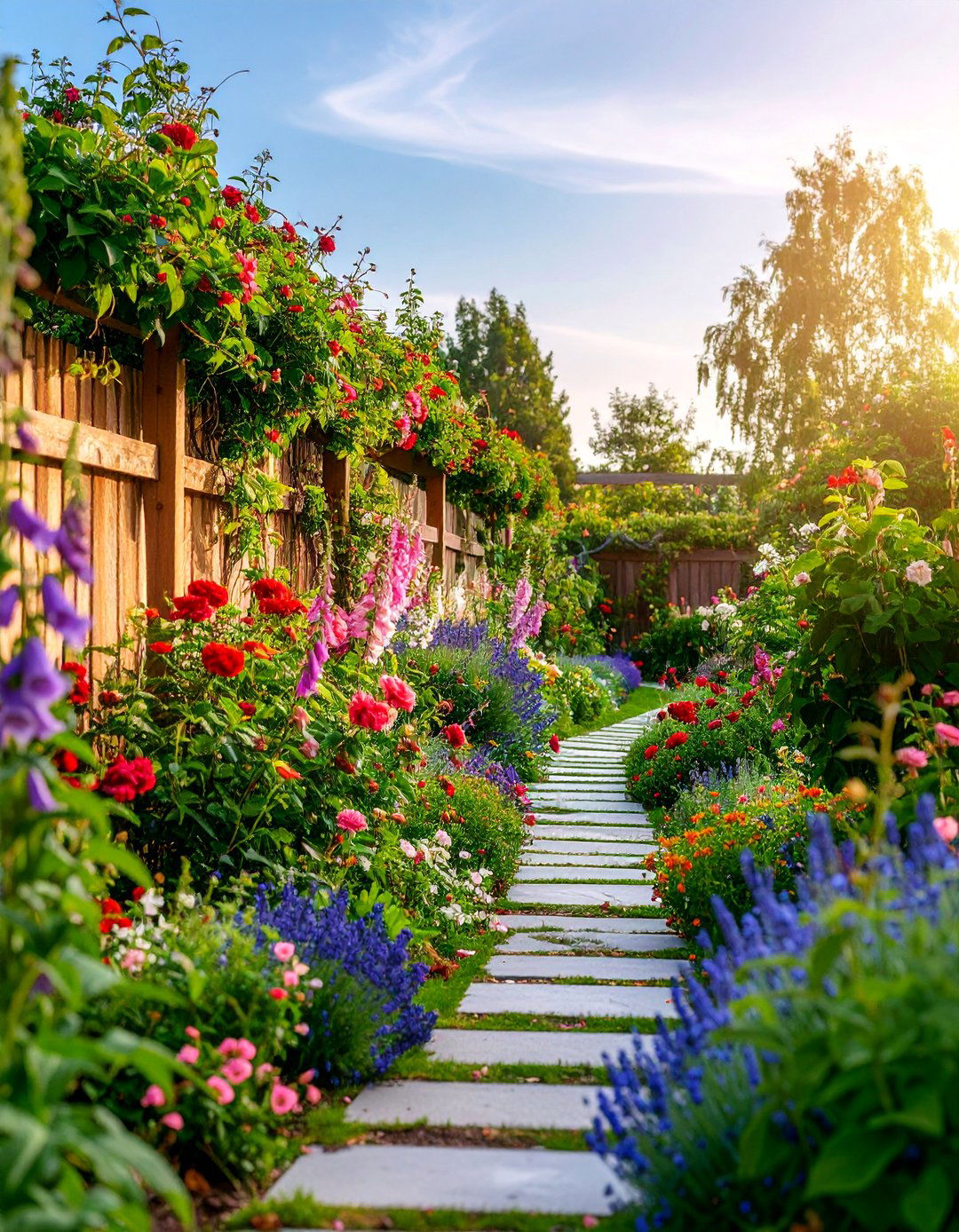
Embrace romantic abundance with this traditional cottage-style perennial arrangement featuring beloved old-fashioned flowers in informal groupings. Delphiniums provide towering blue spires alongside pink and white foxgloves, creating vertical drama throughout the border. Roses weave between perennials, offering continuous blooms and classic fragrance. Hardy geraniums form colorful carpets beneath taller plants, while lady's mantle creates soft green transitions. Catmint and lavender contribute aromatic elements alongside cheerful hollyhocks and sweet peas climbing rustic supports. The design allows plants to self-seed naturally, creating casual charm and unexpected color combinations. Dense plantings minimize maintenance while maximizing visual impact. This timeless style combines beauty with practicality, incorporating both ornamental and culinary herbs for complete cottage garden authenticity.
5. Modern Minimalist Perennial Design
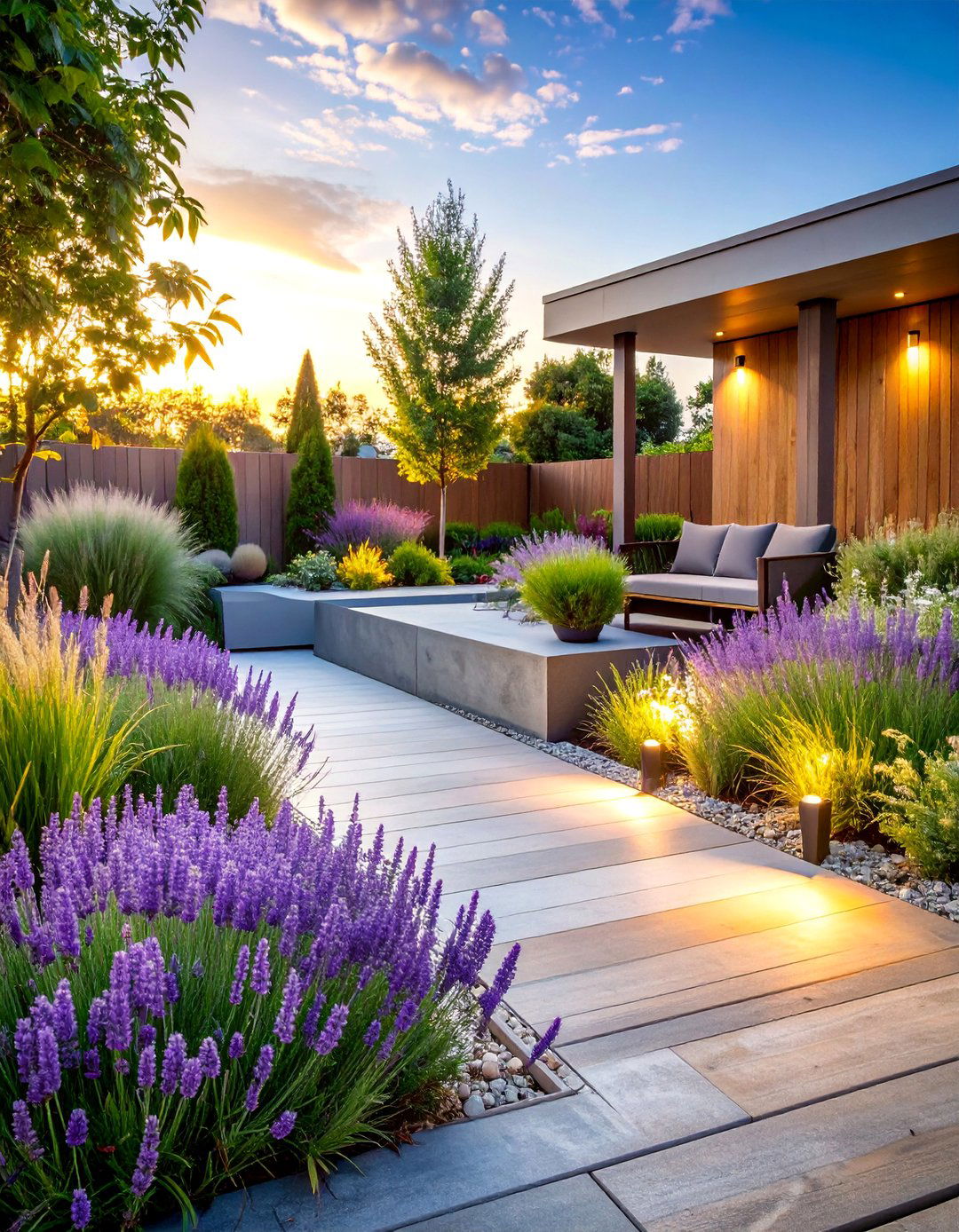
This contemporary approach emphasizes clean lines, structural plants, and sophisticated color restraint for striking modern appeal. Ornamental grasses like feather reed grass and fountain grass create vertical architecture, complemented by bold perennials in monochromatic schemes. Purple salvia, white echinacea, and silver artemisia form geometric planting blocks with repeated patterns throughout the space. Sedum varieties provide textural interest and seasonal color changes from green to burgundy. The design incorporates hardscaping elements like steel edging and decomposed granite pathways. Plant selections focus on strong form and architectural presence rather than delicate flowers. Maintenance involves precise pruning and deadheading to maintain crisp appearances. This style works exceptionally well in urban settings and contemporary landscapes where simplicity and sophistication take precedence.
6. Four-Season Interest Perennial Border

Design for year-round beauty with carefully orchestrated seasonal transitions featuring plants that provide continuous interest through every season. Spring bulbs emerge through hellebores and early-blooming pulmonaria, followed by summer stalwarts like daylilies, rudbeckia, and phlox. Fall brings brilliant asters, late-blooming anemones, and colorful foliage from perennial geraniums. Winter structure comes from ornamental grasses, sedum seed heads, and evergreen perennials like heuchera and bergenia. Shrub roses and flowering shrubs provide additional framework and extended blooming periods. The design layers early, mid, and late-season performers to ensure seamless transitions between flowering periods. Strategic placement considers both bloom timing and foliage quality, creating dynamic combinations that evolve throughout the year while maintaining consistent visual appeal.
7. Fragrant Perennial Flower Garden
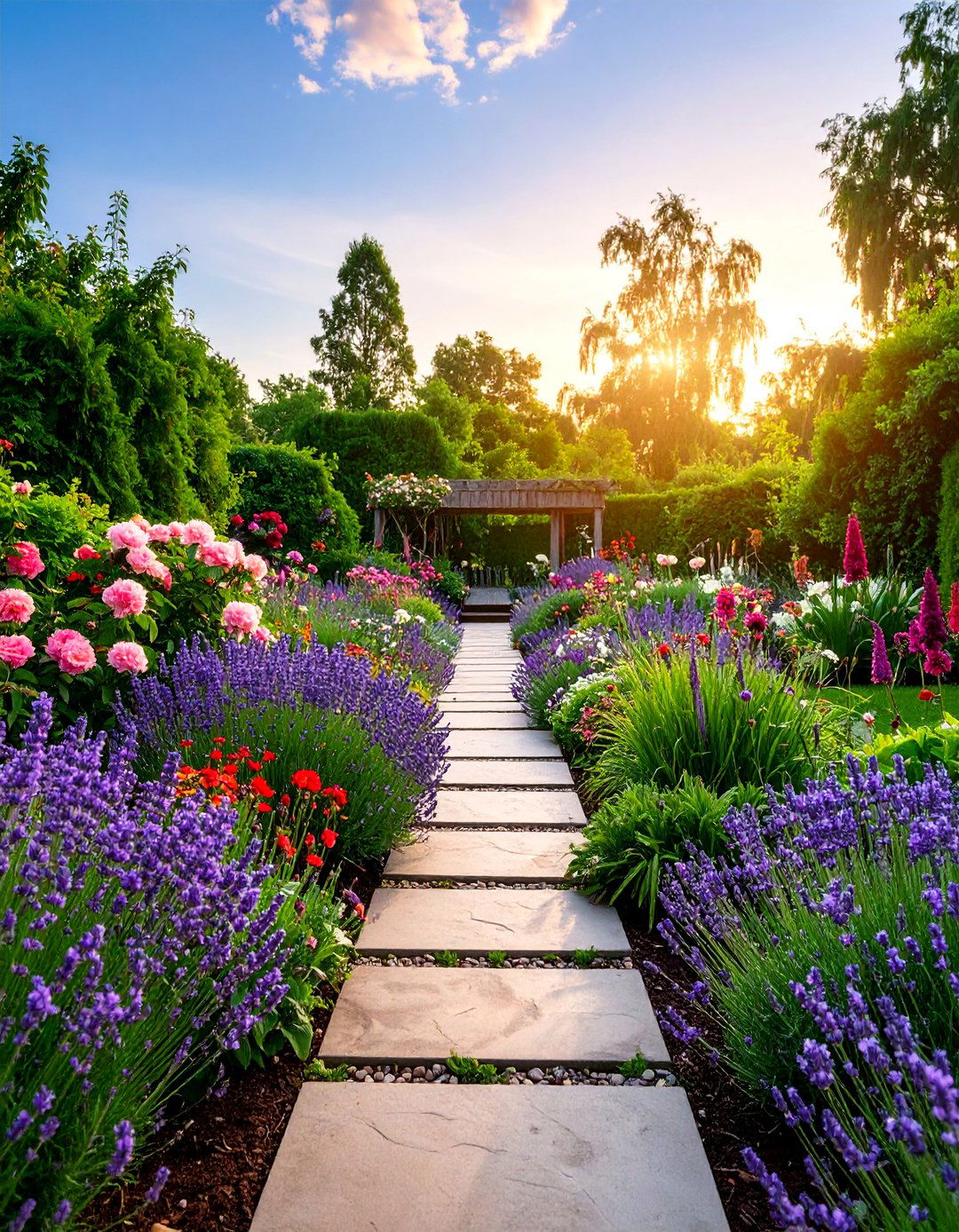
Engage the senses with this aromatic collection featuring perennials chosen specifically for their delightful fragrances and continuous scent throughout the growing season. Lavender varieties form the fragrant backbone, complemented by sweet-scented pinks, aromatic herbs like rosemary and thyme, and evening-fragrant stocks. Peonies provide intense spring perfume, while summer phlox and tuberose offer rich nighttime scents. Fragrant hostas and sweet woodruff thrive in shadier areas, extending aromatic appeal throughout the garden. The design positions plants near seating areas and pathways for maximum scent appreciation. Different fragrances peak at various times, creating changing aromatic experiences from morning through evening. Plant placement considers wind patterns to distribute fragrances effectively while grouping compatible scents for harmonious blending rather than overwhelming competition.
8. Native Wildflower Perennial Meadow
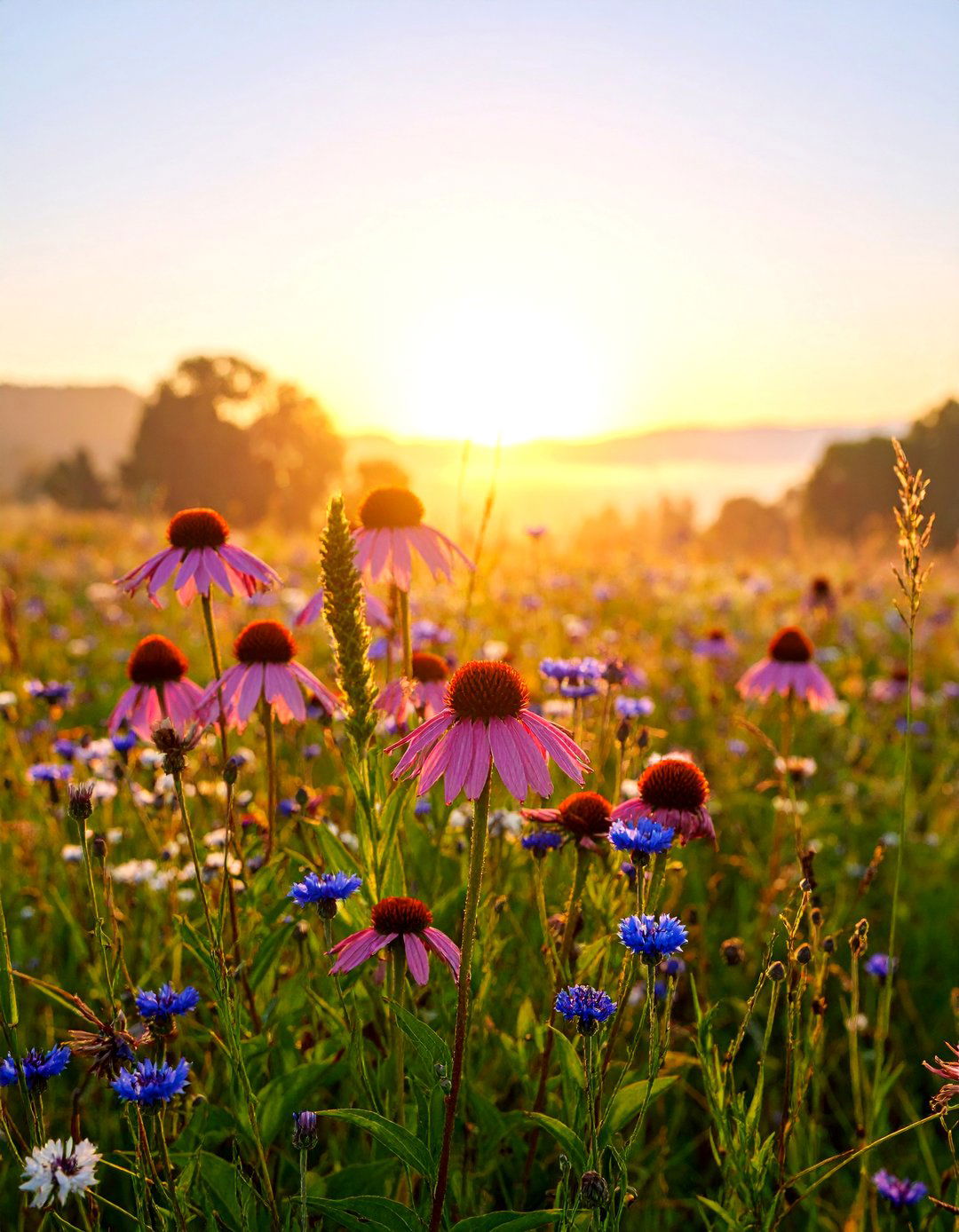
Create an authentic naturalistic display using regionally appropriate native perennials that support local ecosystems while providing stunning seasonal beauty. Local wildflowers like purple coneflower, wild bergamot, and native asters form the foundation, complemented by indigenous grasses and sedges. Regional variations might include California poppies, Texas bluebonnets, or New England asters depending on location. The design mimics natural plant communities with irregular drifts and scattered groupings rather than formal arrangements. Native plants require minimal irrigation and fertilization once established, making this approach both environmentally sustainable and low-maintenance. Wildlife benefits include food sources for native pollinators, birds, and beneficial insects. Seasonal changes reflect natural cycles, with spring emergence, summer blooming, fall seed production, and winter dormancy creating authentic ecosystem rhythms throughout the year.
9. Shade-Loving Perennial Sanctuary
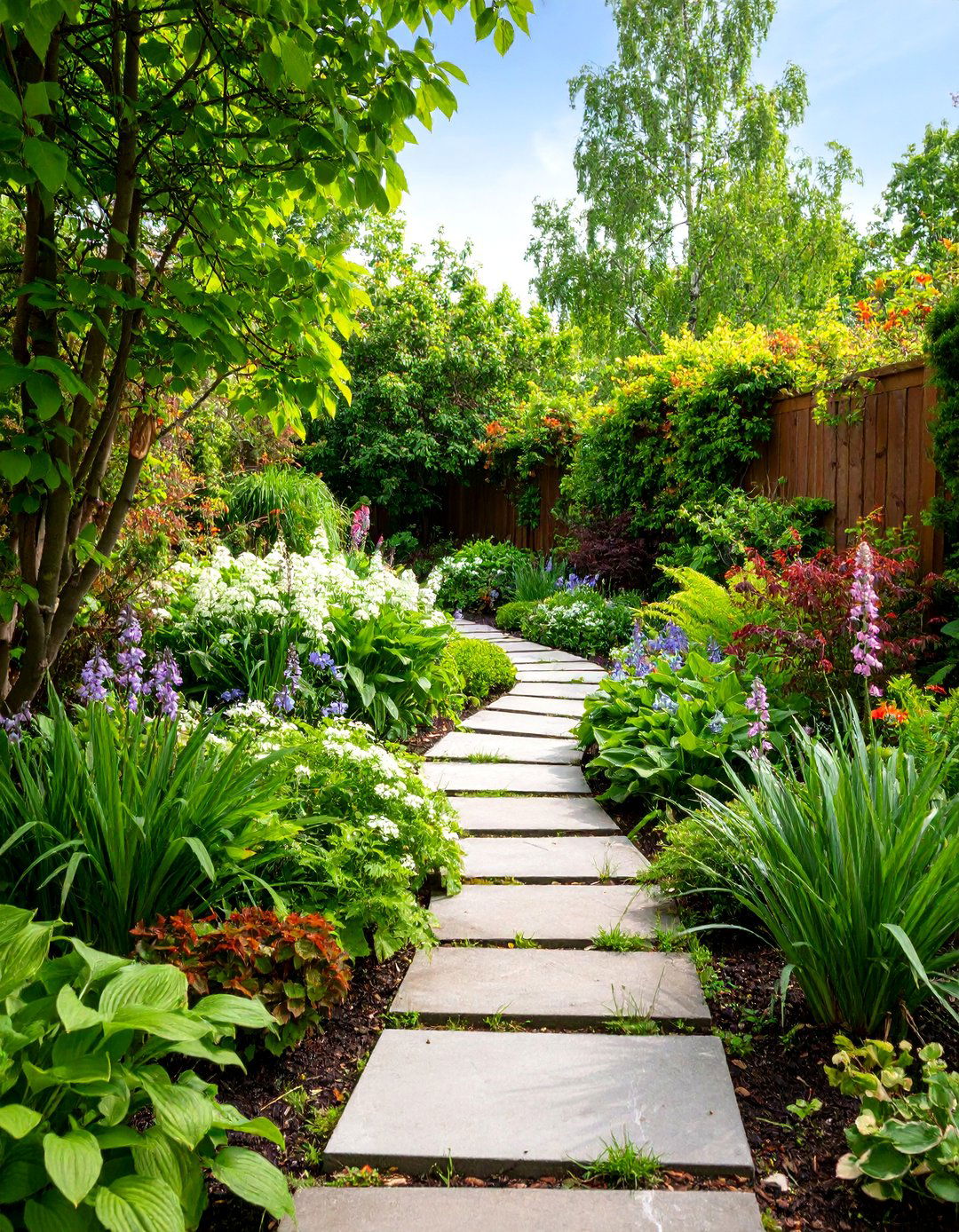
Transform challenging shaded areas into lush, colorful retreats using shade-tolerant perennials that thrive in reduced light conditions. Hostas in various sizes and leaf patterns create dramatic foliage displays, while astilbe provides delicate, feathery flowers in white, pink, and red. Heuchera contributes colorful leaves in purple, bronze, and lime green, complemented by the heart-shaped foliage of brunnera. Ferns add textural diversity alongside Solomon's seal and wild ginger. Spring ephemeral wildflowers like trillium and bloodroot provide early season interest before tree canopy fully develops. The design emphasizes foliage color, texture, and form since flowering may be more limited in deep shade. Careful attention to soil moisture and organic matter content ensures healthy plant establishment and long-term success in these challenging growing conditions.
10. Hot Color Perennial Fire Garden
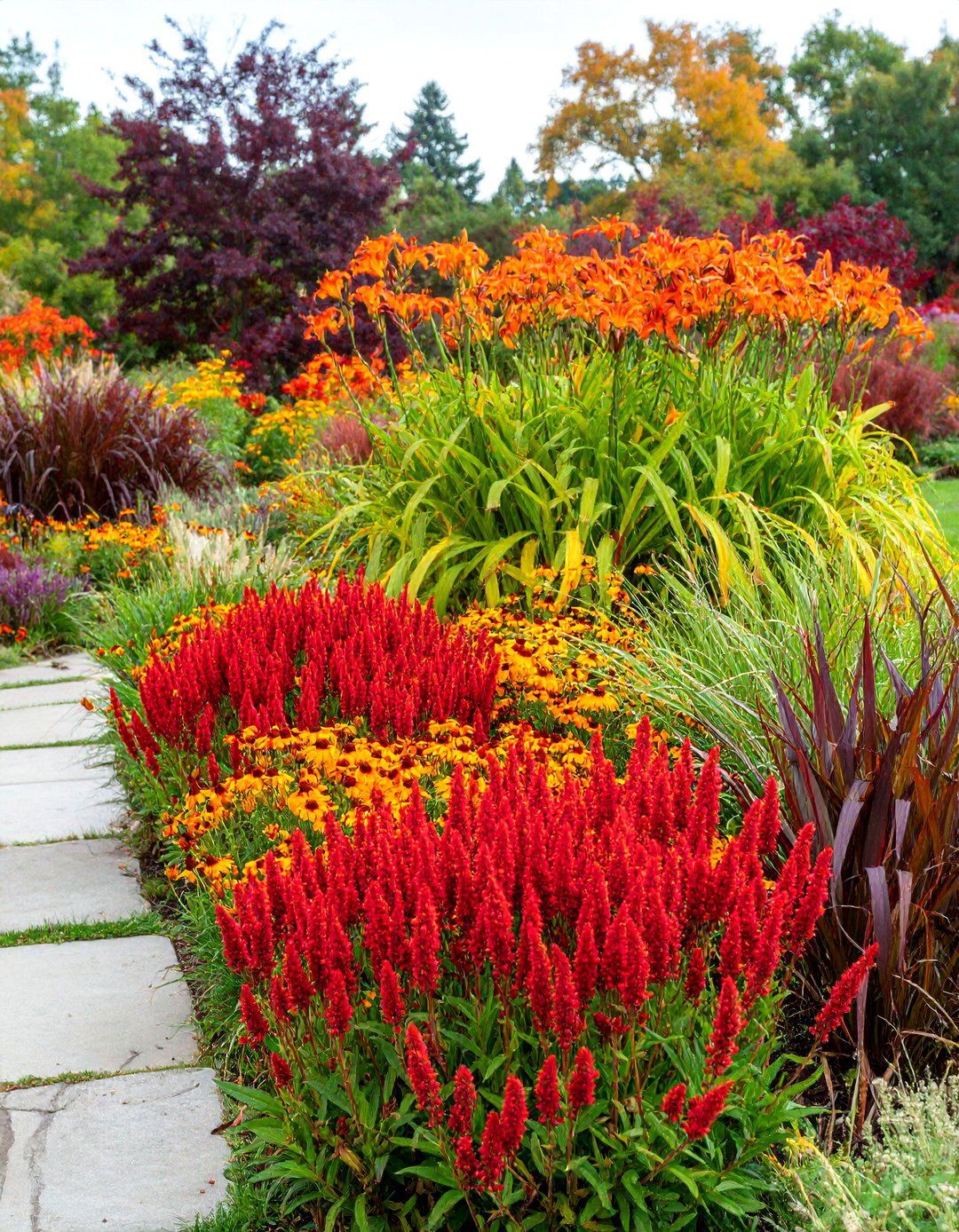
Ignite the landscape with this bold, energetic design featuring warm-toned perennials in reds, oranges, and yellows that create vibrant, eye-catching displays. Red hot poker plants provide dramatic vertical spikes, while orange butterfly weed and yellow rudbeckia form colorful foundations. Crocosmia adds fiery orange blooms on arching stems, complemented by red bee balm and golden coreopsis. Hot-colored daylilies in orange and red varieties contribute ongoing summer color, while red-leafed heuchera maintains intensity throughout the season. The design incorporates bronze and burgundy foliage plants that harmonize with flower colors while providing structural interest. This high-energy combination works particularly well in full sun locations where intense colors won't fade. Careful plant spacing ensures adequate air circulation while maintaining the bold visual impact of massed hot colors throughout the growing season.
11. Cool Color Perennial Serenity Garden

Create peaceful, calming spaces using cool-toned perennials in blues, purples, and whites that promote relaxation and tranquil garden experiences. Blue delphiniums and tall campanulas provide vertical structure, while purple catmint and white sweet alyssum form flowing ground-level carpets. Lavender contributes both color and soothing fragrance, complemented by blue-flowered asters and white phlox. Silver-leafed plants like artemisia and lamb's ear bridge color transitions while adding textural interest. Purple salvia and white echinacea extend blooming periods through multiple seasons. The design emphasizes gentle color progressions rather than stark contrasts, creating harmonious blending that promotes peaceful contemplation. Strategic placement near seating areas enhances the calming effect, while evening viewing reveals how cool colors seem to glow in twilight conditions, extending garden enjoyment into evening hours.
12. Woodland Edge Perennial Garden
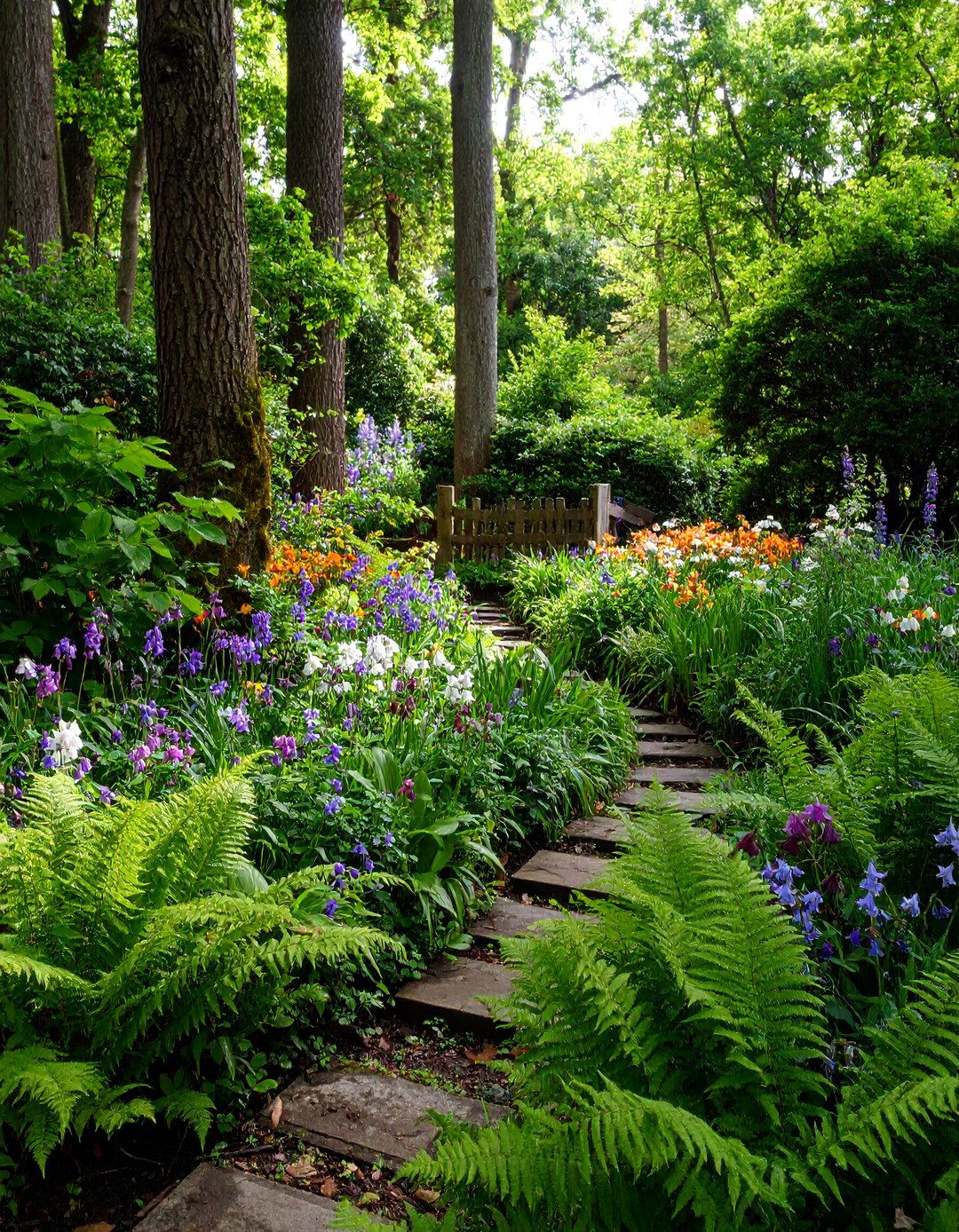
Bridge the transition between formal garden spaces and natural woodland areas with this specialized collection designed for partial shade and woodland conditions. Coral bells and foam flower thrive in dappled sunlight, providing delicate blooms and attractive foliage. Wild columbine and native phlox add natural charm, while ferns create lush background texture. Spring-blooming bloodroot and trillium provide early season interest before canopy development. The design incorporates natural materials like fallen logs and rock outcroppings to enhance the woodland aesthetic. Plant selection emphasizes native species that naturally occur in forest edge environments. Organic mulch from leaf mold maintains soil moisture and fertility while supporting beneficial soil organisms. This transitional design helps integrate cultivated garden areas with existing natural landscapes, creating seamless connections between human-designed and naturally occurring plant communities.
13. Cutting Garden Perennial Collection
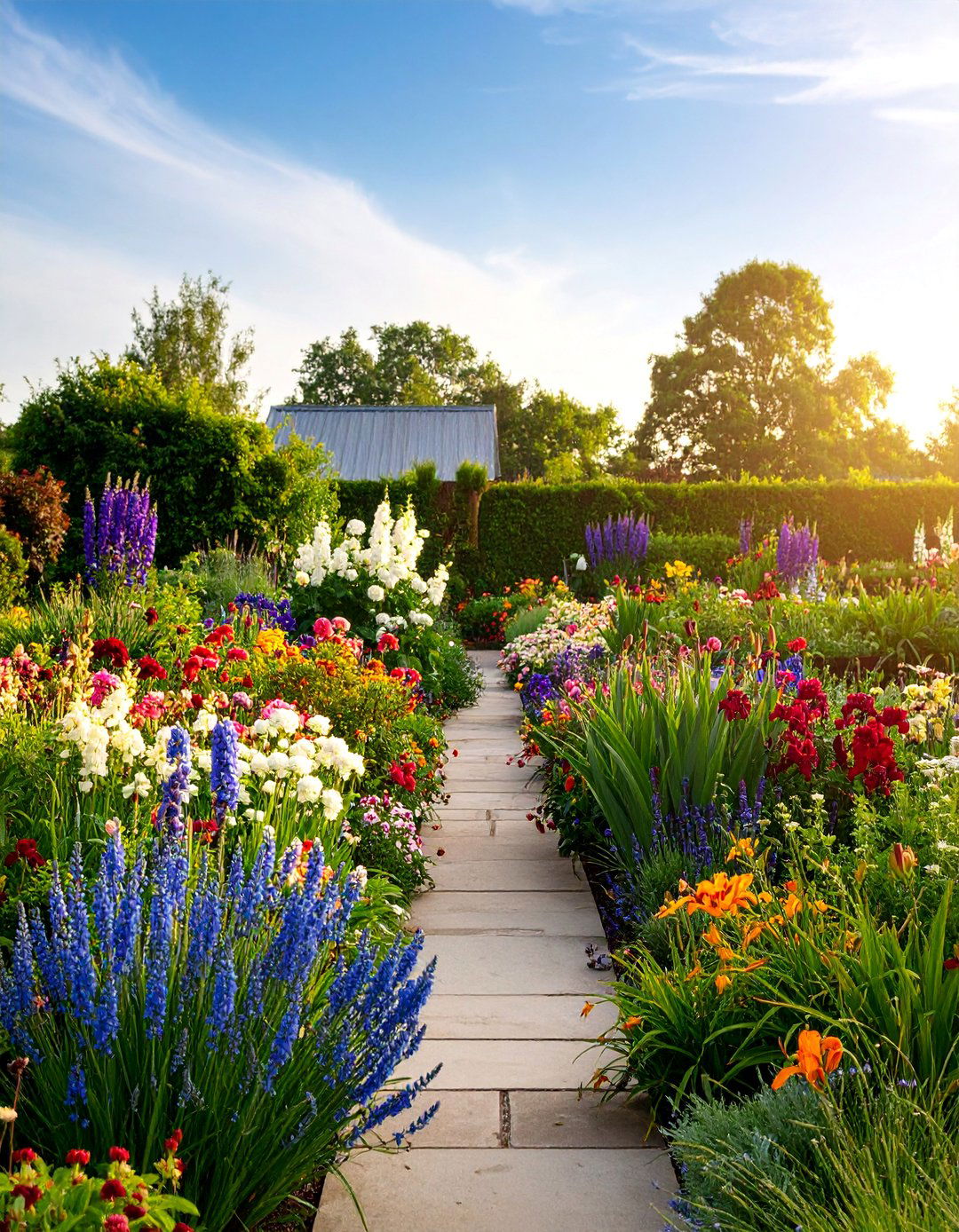
Design specifically for flower production with this practical yet beautiful arrangement featuring perennials that provide abundant blooms for indoor arrangements and bouquets. Tall-growing peonies, delphiniums, and lilies provide substantial stems, while medium-height plants like coneflowers, phlox, and asters fill out arrangements. Long-stemmed varieties of daylilies and iris contribute unique forms and colors. The design organizes plants in rows or blocks for easy harvest access while maintaining attractive garden appearance. Succession planting ensures continuous bloom availability throughout the growing season. Plants are selected for stem strength, vase life, and flower quality rather than purely landscape value. Regular cutting actually encourages more blooms from many perennials, making this a productive and beautiful garden style. Storage and processing areas can be integrated discretely for post-harvest conditioning and arrangement preparation.
14. Xeriscape Perennial Water-Wise Garden
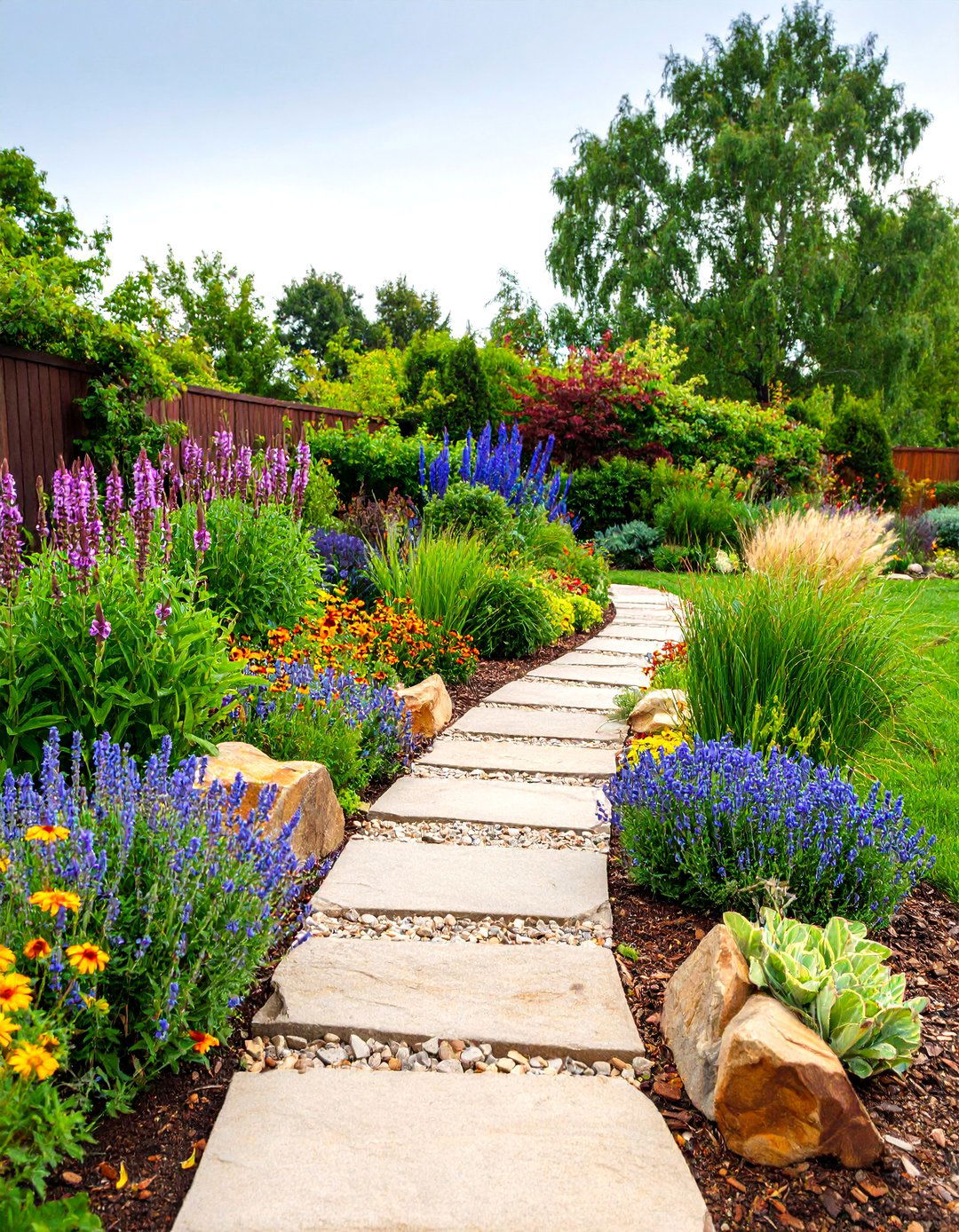
Master water conservation while maintaining garden beauty through this drought-tolerant collection requiring minimal irrigation once established in appropriate climates. Russian sage provides silver foliage and purple blooms, while sedums offer succulent textures and fall color. Native ornamental grasses like buffalo grass and blue grama create movement and seasonal interest. Blanket flower and prairie coneflower deliver bright colors with minimal water needs. The design incorporates mulching strategies and soil amendments that improve water retention and plant establishment. Gravel pathways and hardscaping elements reduce overall water requirements while adding structural interest. Plant selection emphasizes species adapted to local climate conditions rather than high-maintenance exotic varieties. This sustainable approach reduces environmental impact while creating resilient gardens that thrive during drought conditions and require less maintenance than traditional high-water landscapes.
15. Vertical Perennial Border Design
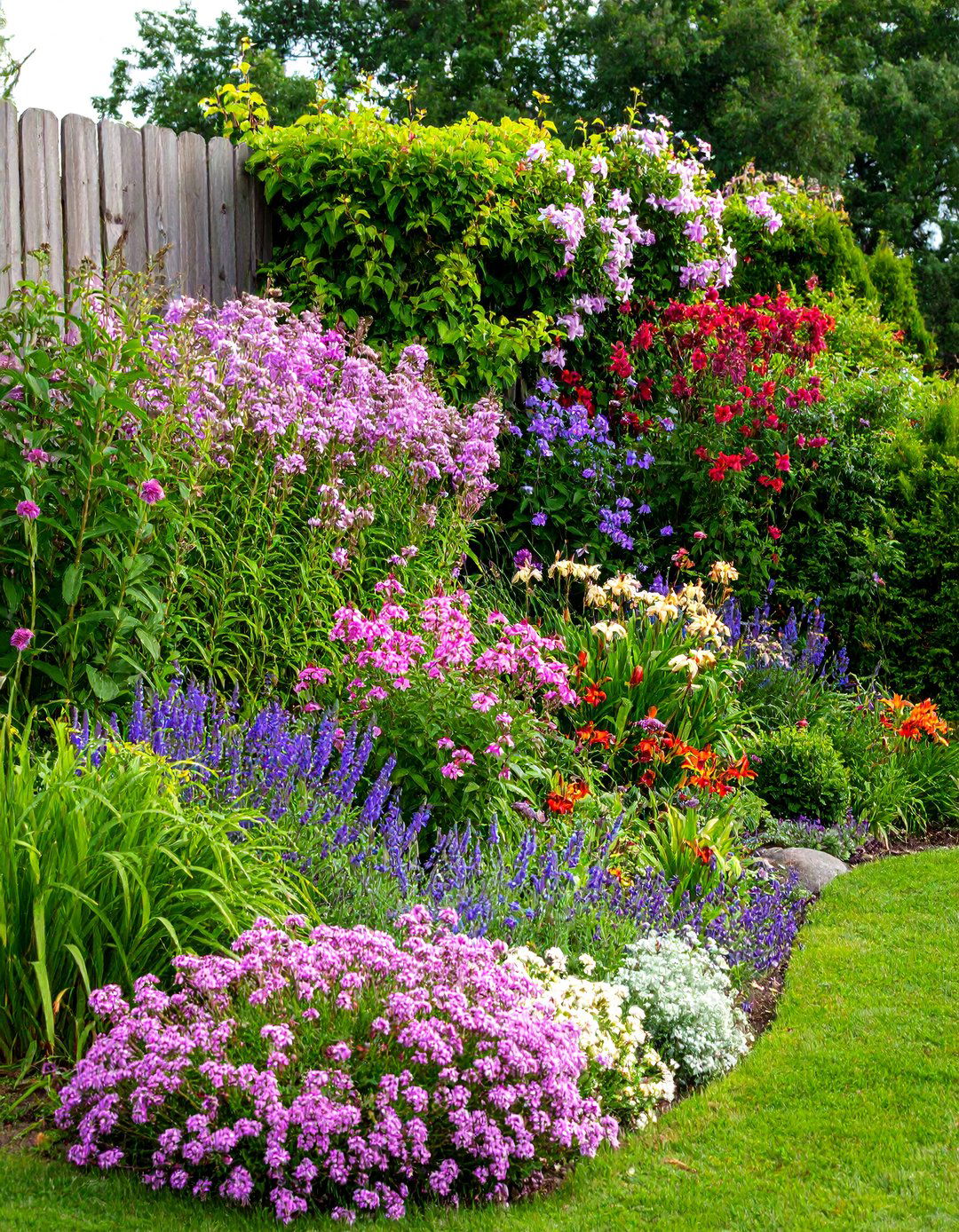
Maximize visual impact and growing space through strategic height layering that creates dramatic vertical interest and efficient space utilization. Tall background plants like joe-pye weed, tall phlox, and ornamental grasses establish the uppermost layer. Mid-height perennials such as coneflowers, daylilies, and bee balm form the middle tier, while low-growing sedums, ajuga, and creeping phlox create ground-level interest. The design ensures proper sun exposure for all layers while creating natural support systems where shorter plants help stabilize taller ones. Climbing perennials on trellises or obelisks add additional vertical elements without consuming ground space. Careful color coordination throughout all levels maintains visual cohesion while providing seasonal interest at every height. This approach works particularly well in narrow spaces where depth is limited but vertical growing room is available.
16. Butterfly and Hummingbird Perennial Haven
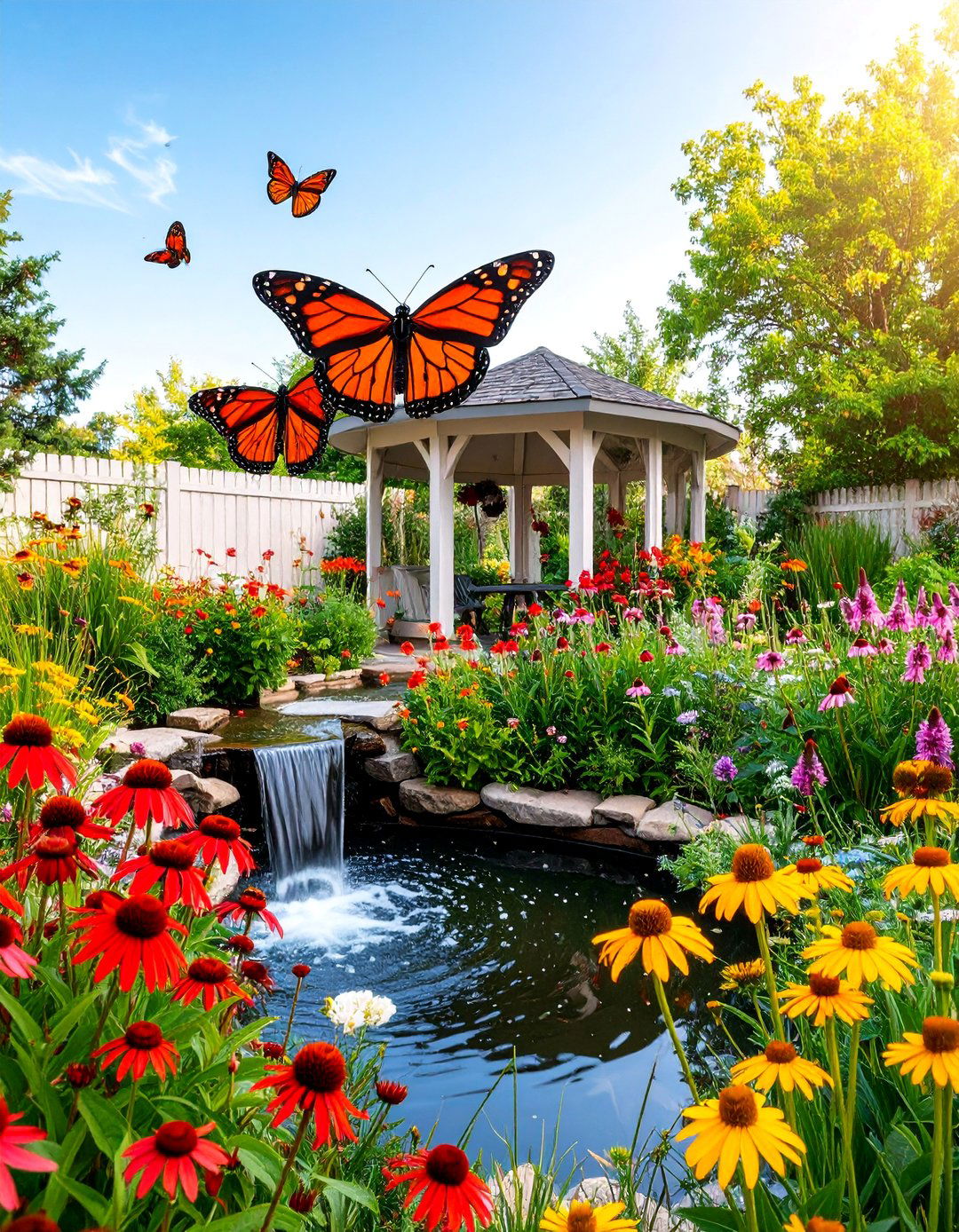
Attract and support flying wildlife with this specialized collection featuring perennials that provide nectar, nesting materials, and habitat for butterflies and hummingbirds. Red cardinal flower and bee balm appeal specifically to hummingbirds, while purple coneflower and butterfly weed serve butterfly needs. Native milkweed species support monarch butterfly reproduction, complemented by asters that provide late-season nectar sources. The design includes host plants for butterfly caterpillars alongside nectar sources for adults. Continuous blooming sequences ensure food availability throughout migration and breeding seasons. Plant groupings are sized for efficient foraging, while avoiding pesticides maintains safe habitat conditions. Water sources like shallow dishes or small fountains provide drinking and bathing opportunities. Strategic placement near windows allows indoor wildlife observation while providing educational opportunities about pollinator relationships and conservation.
17. Ornamental Grass Perennial Combination
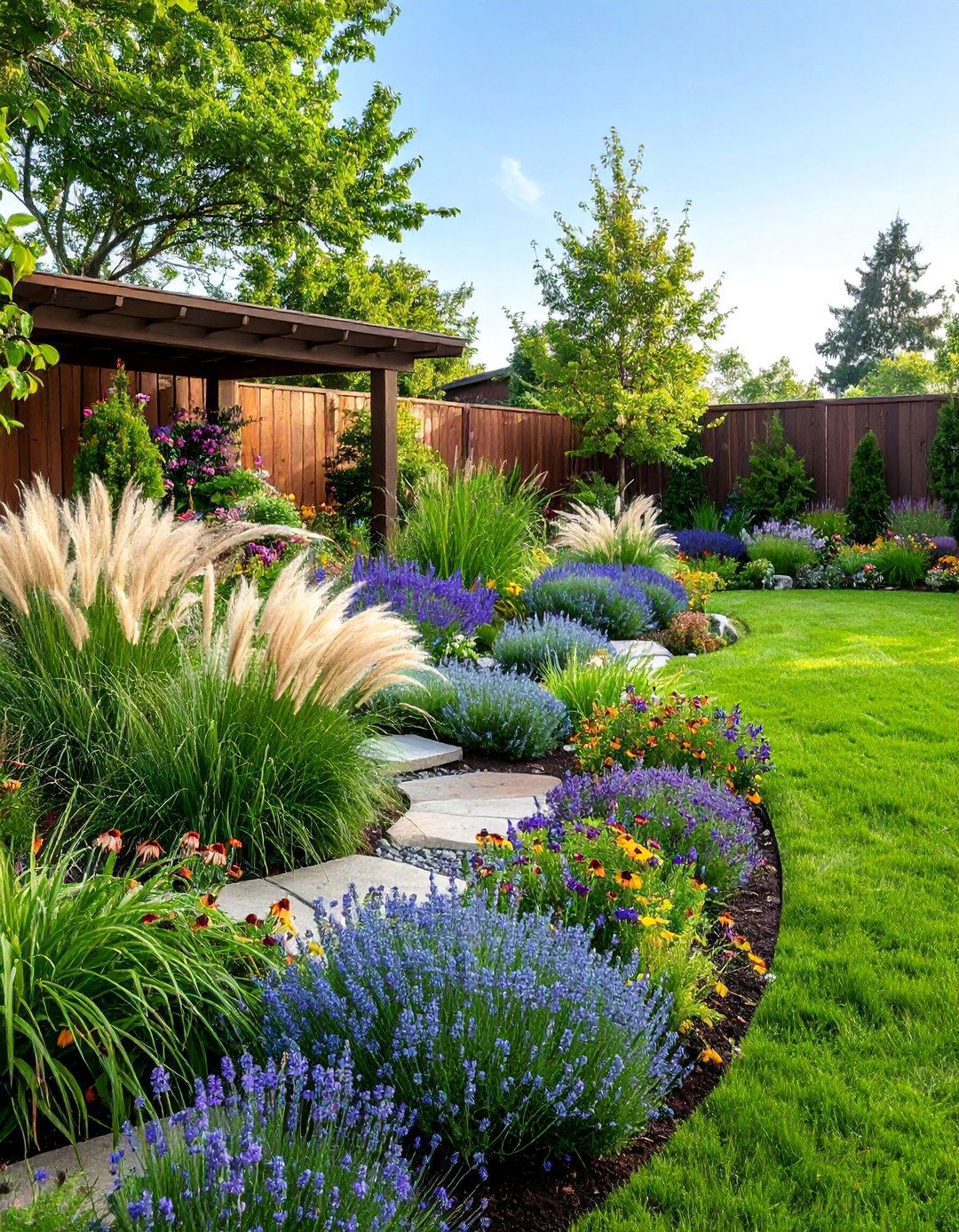
Blend the architectural beauty of ornamental grasses with complementary perennials for dynamic texture, movement, and year-round interest in contemporary landscape designs. Fountain grass and feather reed grass provide vertical structure, while shorter grasses like Japanese forest grass create flowing ground-level movement. Perennial partners include purple coneflower, black-eyed Susan, and asters that contrast beautifully with grass textures. The design emphasizes natural movement and seasonal changes, with grasses providing winter structure after perennial flowers fade. Different grass varieties offer varying colors, from blue fescue to burgundy fountain grass, creating diverse palettes throughout the seasons. Strategic placement allows wind to activate grass movement, adding kinetic energy to garden displays. This combination works exceptionally well in modern landscapes where naturalistic movement and seasonal change are valued over static formal arrangements.
18. Traditional English Herbaceous Border
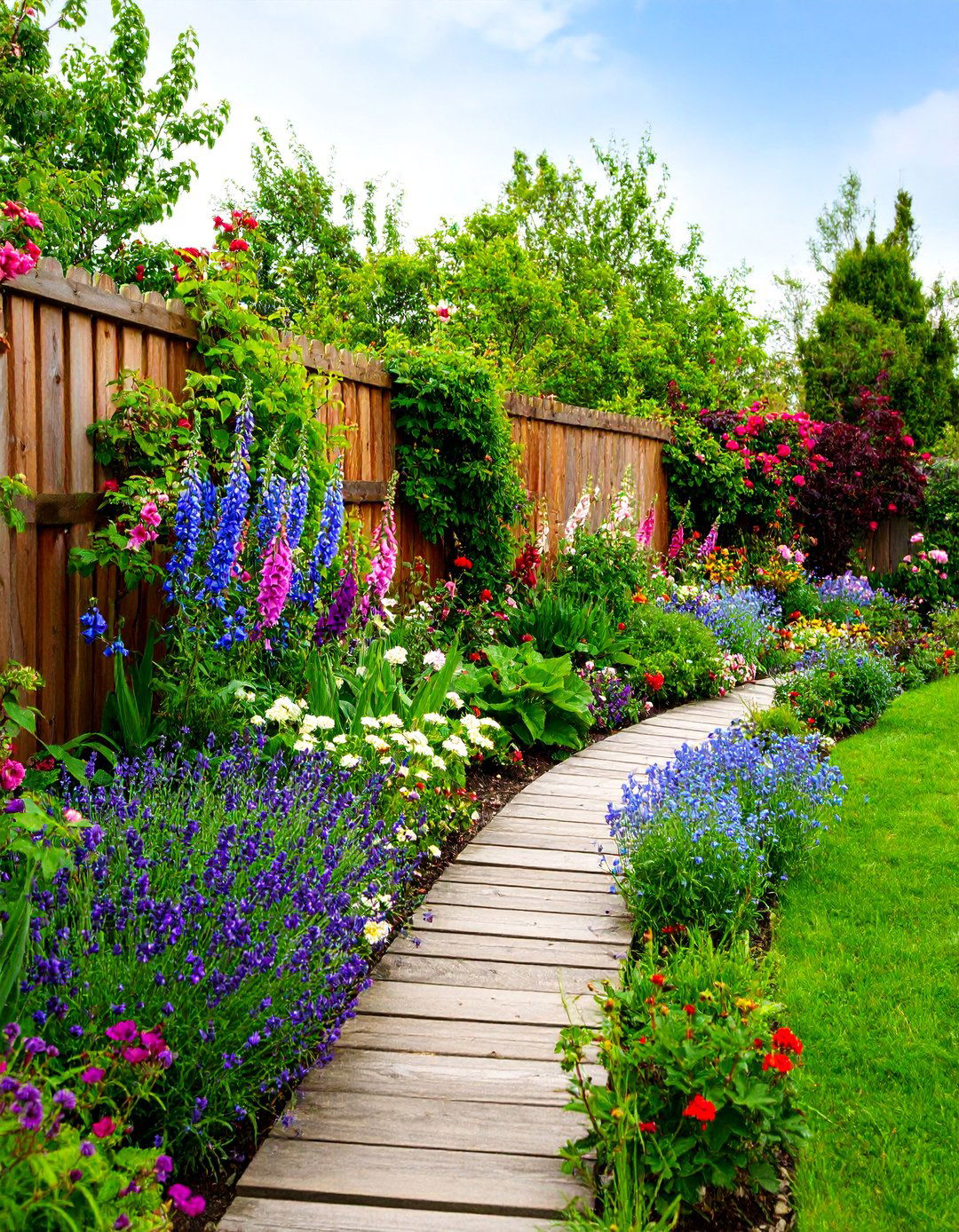
Recreate classic British garden style with this sophisticated arrangement featuring traditional perennials in carefully orchestrated color schemes and seasonal progressions. Delphiniums, foxgloves, and hollyhocks provide cottage garden charm alongside refined roses and peonies. The design follows traditional height progression with careful attention to bloom timing and color harmony. Classic combinations like pink roses with purple catmint and blue delphiniums with white phlox create time-tested appeal. Herbaceous peonies, hardy geraniums, and lady's mantle contribute authentic English garden character. The design requires regular maintenance including staking, deadheading, and seasonal cleanup but rewards with spectacular displays. Traditional materials like wooden plant supports and gravel pathways enhance authenticity. This style works best in cooler, moister climates where traditional English garden plants thrive naturally, creating impressive displays that have inspired gardeners for centuries.
19. Compact Small Space Perennial Design
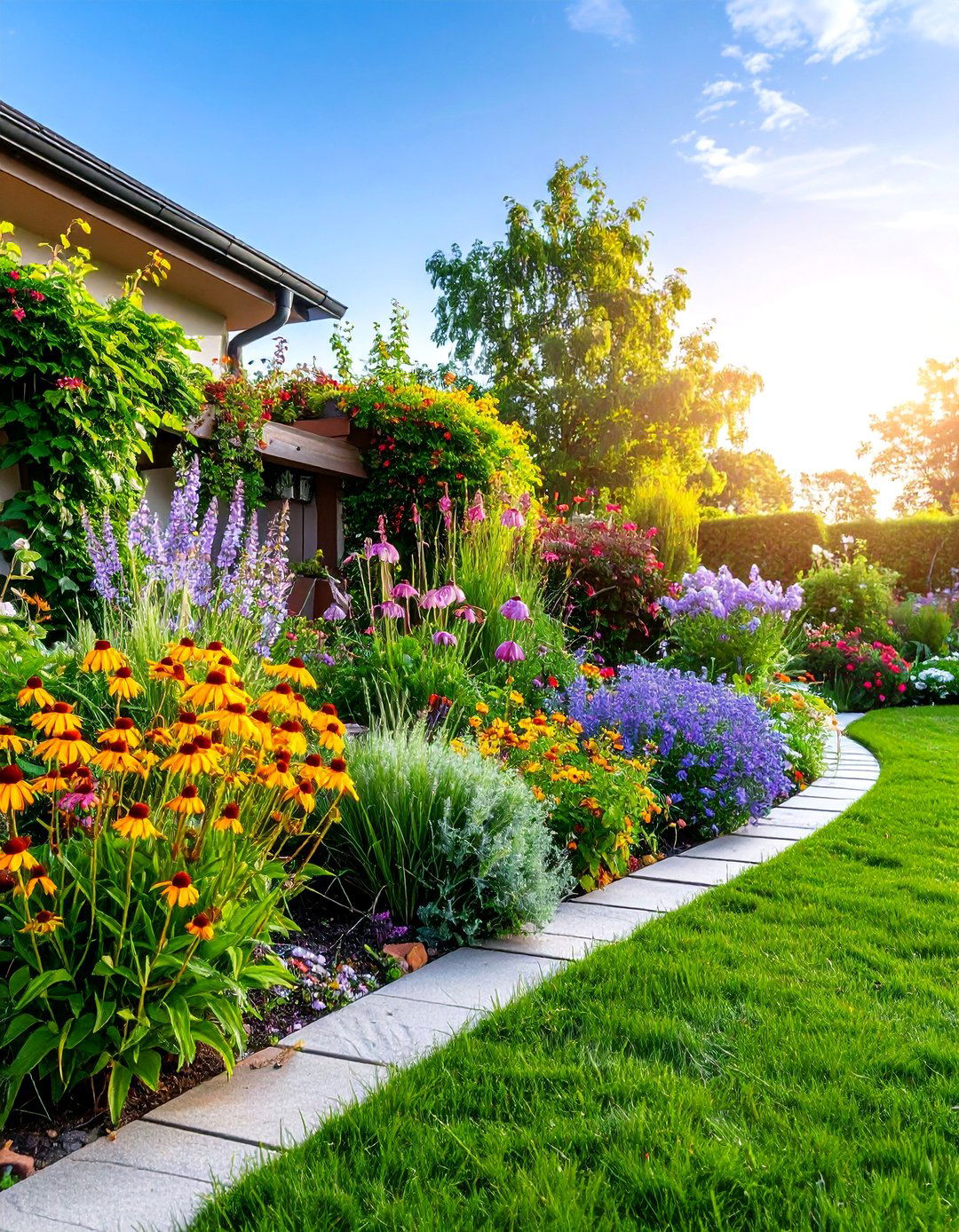
Maximize limited growing areas with this efficient collection designed specifically for small gardens, containers, and urban spaces where every square foot counts. Dwarf varieties of popular perennials like compact coneflowers, miniature hostas, and small ornamental grasses provide full-size impact in reduced space. Vertical elements like climbing clematis and wall-mounted planters extend growing area upward. The design emphasizes multi-season plants that provide extended value through attractive foliage, interesting seed heads, or multiple bloom periods. Container components allow seasonal rearrangement and easy maintenance access. Strategic use of mirrors and light-colored materials creates illusions of expanded space while reflecting light into darker areas. Plant selection prioritizes compact, well-behaved varieties that won't outgrow their allotted space. This approach proves that spectacular perennial displays are possible regardless of garden size limitations.
20. Prairie-Style Naturalistic Perennial Garden
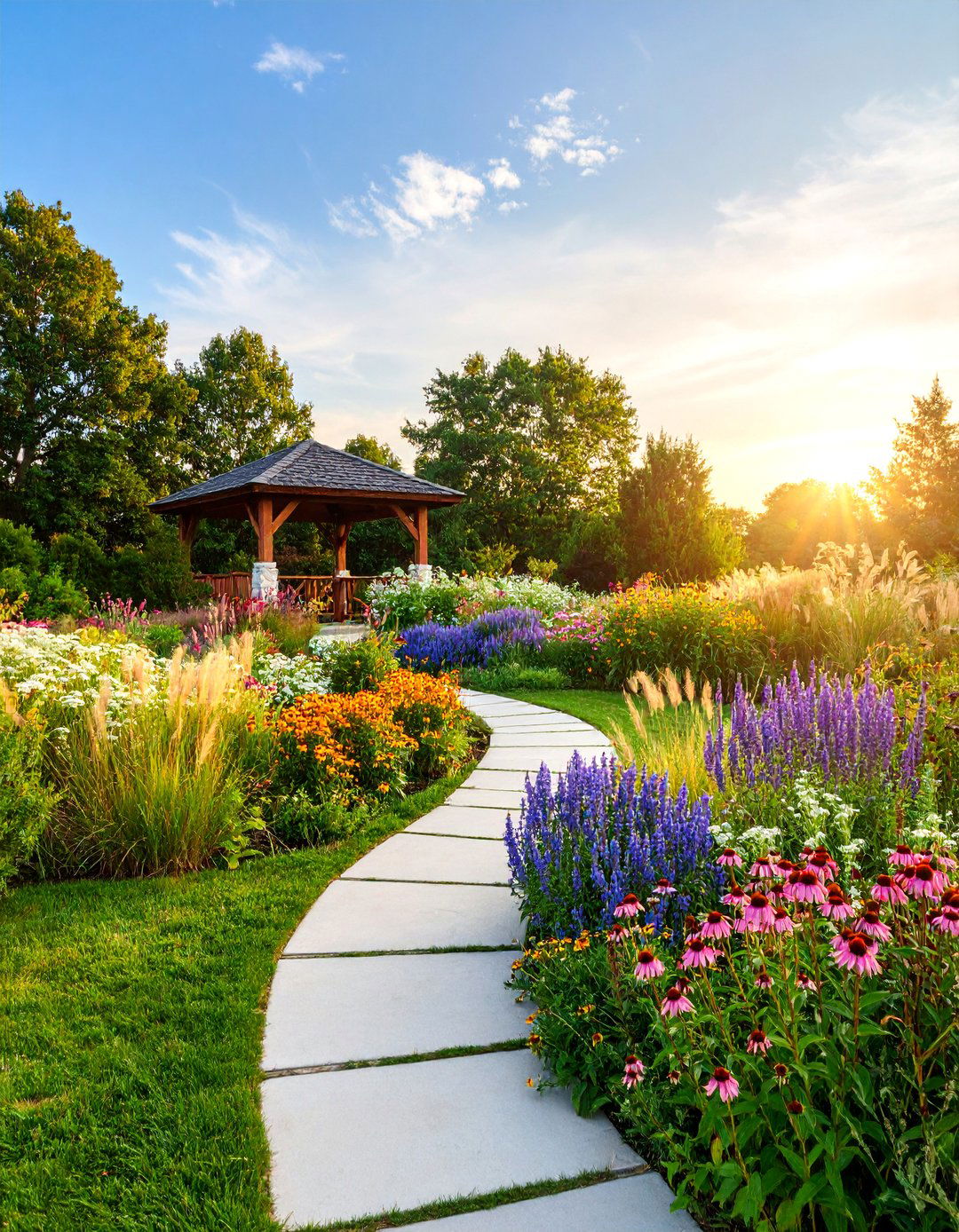
Capture the essence of natural grassland ecosystems with this relaxed, naturalistic design featuring native and adapted perennials in flowing, informal arrangements. Purple coneflower, wild bergamot, and native grasses create authentic prairie character while providing wildlife habitat and low-maintenance beauty. The design emphasizes natural plant communities and seasonal cycles rather than formal structure or continuous color. Plants are allowed to self-seed and naturalize, creating evolving displays that change over time. Native bunch grasses provide structure and winter interest, while wildflowers add seasonal color and pollinator support. Maintenance involves periodic burning or cutting to maintain prairie characteristics and prevent woody plant invasion. This sustainable approach requires minimal inputs while supporting biodiversity and creating educational opportunities about native plant communities and natural ecosystem processes.
21. Evening Garden for Night Enjoyment

Design specifically for after-hours enjoyment with this collection featuring perennials that shine in evening light and provide nighttime fragrance. White flowers and silver foliage reflect available light while fragrant plants release intensified scents during cooler evening hours. Evening primrose opens its blooms at dusk, while four o'clocks provide late-afternoon color and sweet fragrance. White phlox, nicotiana, and tuberose contribute powerful nighttime scents that carry on evening breezes. The design incorporates strategic lighting to enhance plant visibility and create magical evening ambiance. Seating areas are positioned to maximize fragrance appreciation and visual enjoyment. Plant selection emphasizes varieties that perform best during cooler evening temperatures and release fragrances that attract night-flying pollinators. This specialized approach creates unique garden experiences during typically overlooked evening hours.
22. Textural Foliage-Focused Perennial Design
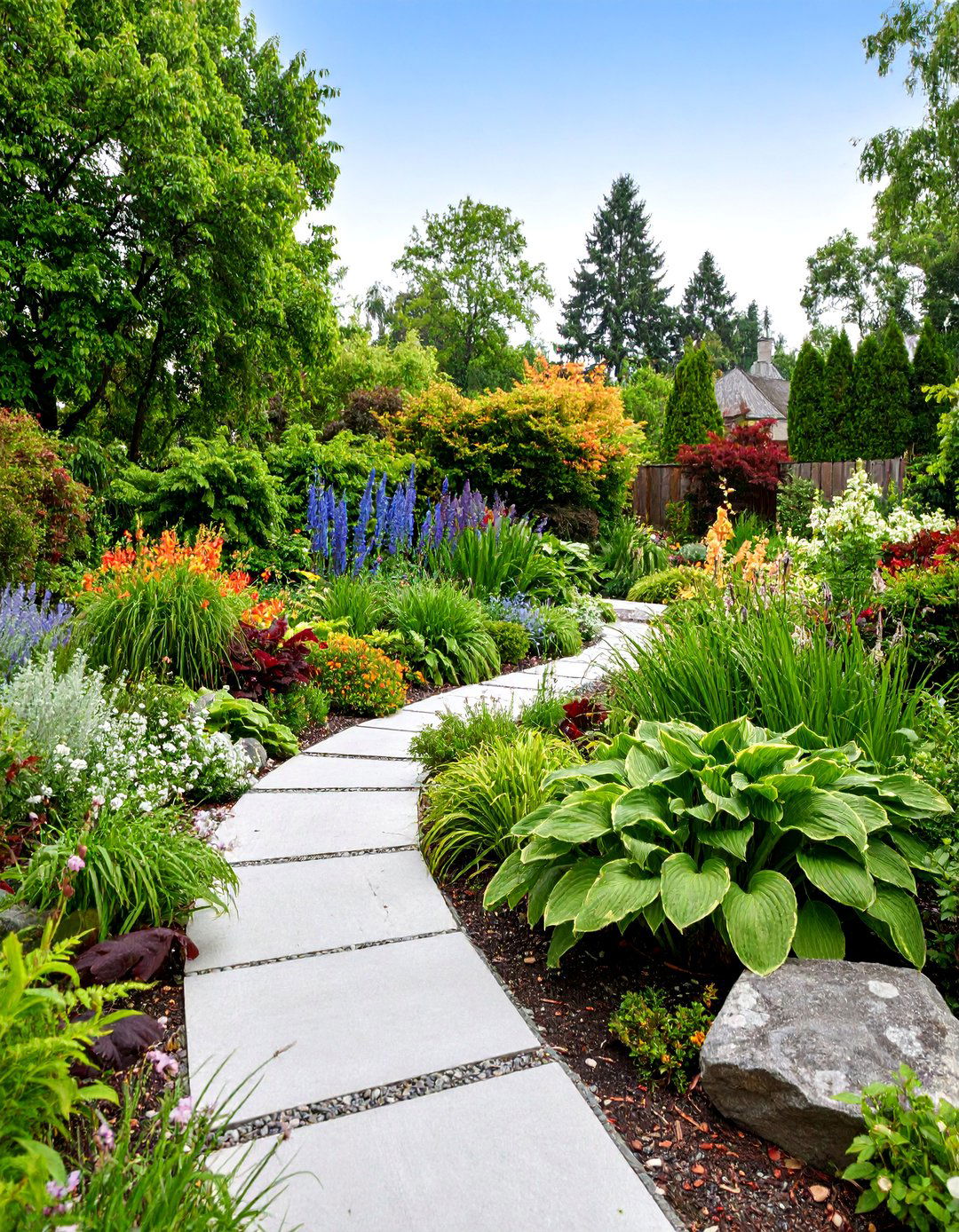
Emphasize form, texture, and foliage color over flowers in this sophisticated design that provides continuous visual interest through plant structure and leaf characteristics. Hostas in various sizes and leaf patterns create bold statements, while ornamental grasses add fine texture and movement. Heuchera contributes colorful foliage in purple, chartreuse, and bronze, complemented by the silver leaves of artemisia and lamb's ear. Ferns provide delicate, feathery texture alongside the broad leaves of ligularia and the spiky forms of yucca or iris. Seasonal foliage changes from emerging spring growth to fall color provide ongoing interest without relying on blooming periods. The design works particularly well in shaded areas where flowering may be limited but foliage plants thrive. Strategic combinations of contrasting textures create dramatic visual impact that remains attractive throughout the entire growing season.
23. Rock Garden Alpine Perennial Collection
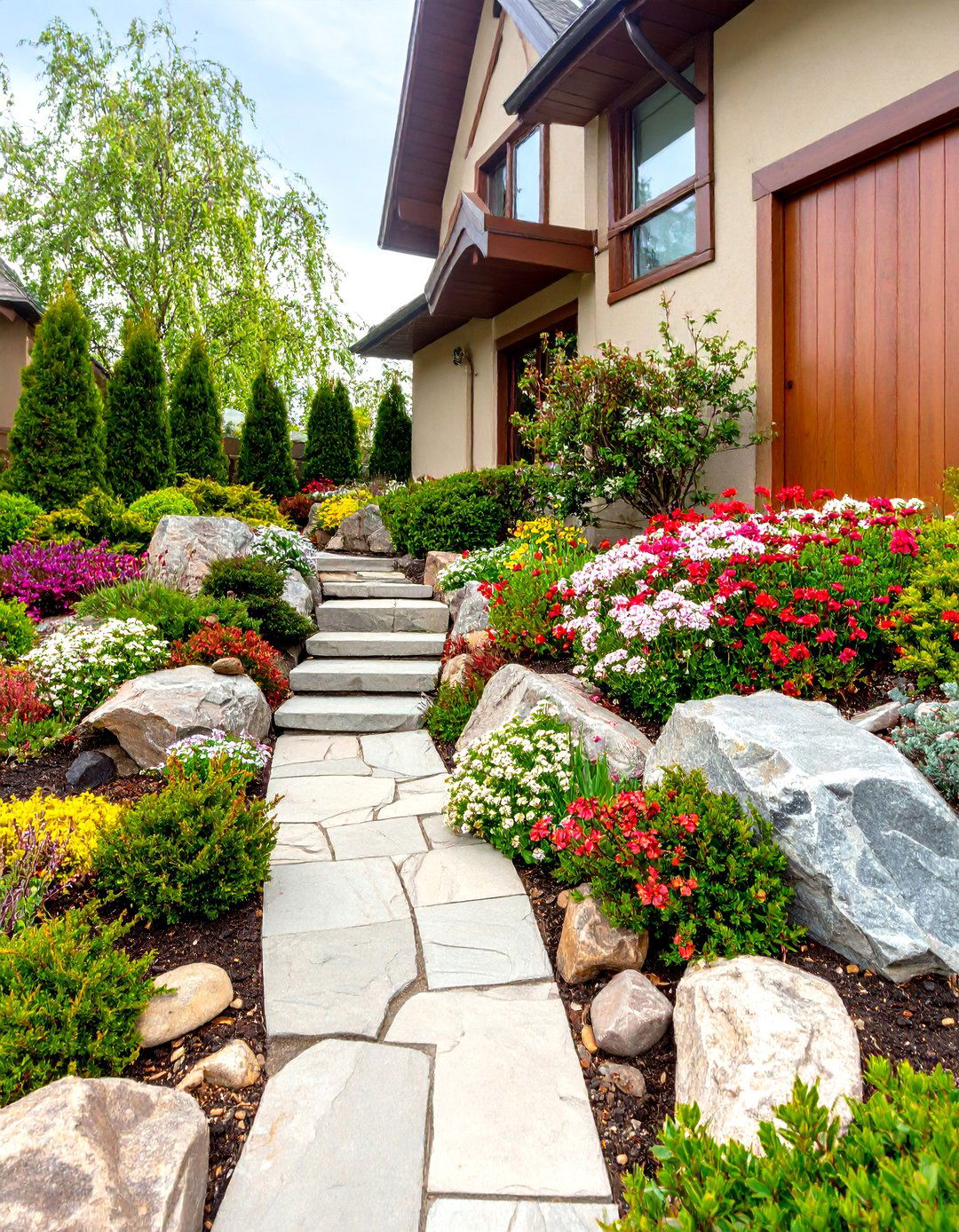
Create dramatic displays in challenging rocky or sloped terrain using specialized perennials adapted to excellent drainage and harsh growing conditions. Sedums and sempervivums thrive in shallow soil pockets, providing succulent textures and unexpected blooms. Creeping phlox cascades over rock faces, creating colorful carpets in spring. Alpine plants like aubrieta and candytuft fill crevices with delicate flowers and trailing growth habits. The design works with existing topography rather than fighting natural conditions, using rocks and slope to create diverse microclimates. Excellent drainage prevents root rot while rocky surfaces provide thermal mass for plant protection. This approach transforms difficult growing areas into spectacular displays while requiring minimal maintenance once established. Strategic plant placement in rock crevices and between stone outcroppings creates naturalistic effects that appear to have developed over geological time.
24. Rain Garden Perennial Water Collection
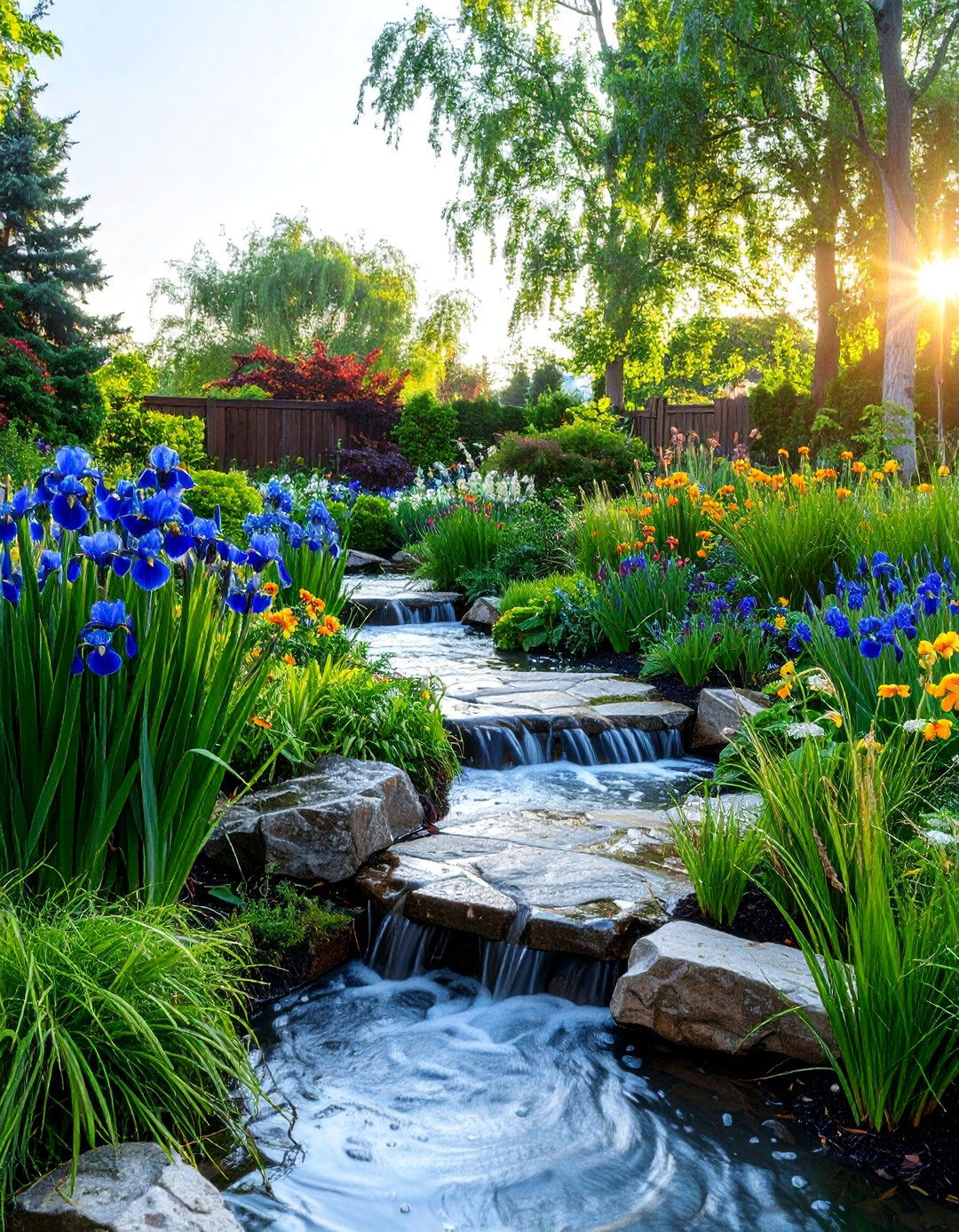
Transform problematic wet areas into beautiful displays using perennials that tolerate periodic flooding while filtering stormwater runoff effectively. Native iris, cardinal flower, and swamp milkweed thrive in temporarily saturated conditions while providing spectacular blooms and wildlife habitat. The design incorporates berms and swales to direct water flow and create varying moisture zones for different plant requirements. Ornamental grasses like switch grass and sedges provide structure while helping absorb excess water. Plants are selected for their ability to handle both wet and dry periods, creating resilient displays that function during various weather conditions. This environmentally beneficial approach reduces erosion and pollution while creating beautiful garden features from challenging drainage situations. Strategic placement helps protect structures and landscapes from water damage while supporting local water quality.
25. Succession Planting Perennial Border

Ensure continuous color and interest throughout the entire growing season with this carefully orchestrated design featuring overlapping bloom times and strategic plant combinations. Early-season bulbs and hellebores provide initial color, followed by spring perennials like pulmonaria and brunnera. Summer brings peak blooming with coneflowers, phlox, and bee balm, while fall extends displays with asters, anemones, and late-blooming sedums. Winter interest comes from ornamental grasses, evergreen perennials, and persistent seed heads. The design requires detailed planning to coordinate bloom timing and ensure seamless transitions between seasonal peaks. Strategic deadheading and maintenance encourage extended blooming periods from key plants. This approach creates gardens that remain attractive and engaging throughout the entire year rather than having distinct peak and dormant periods. Careful plant selection and placement create layered displays where something is always in peak condition.
Conclusion:
Creating stunning perennial flower beds requires thoughtful planning that considers site conditions, maintenance preferences, and desired aesthetic outcomes. Whether pursuing Mediterranean drought tolerance, cottage garden romance, or modern minimalism, successful designs combine plants with complementary growing requirements and seasonal interest. These twenty-five diverse approaches demonstrate how perennial gardens can serve various functions while providing years of beauty and enjoyment with proper plant selection and design principles.


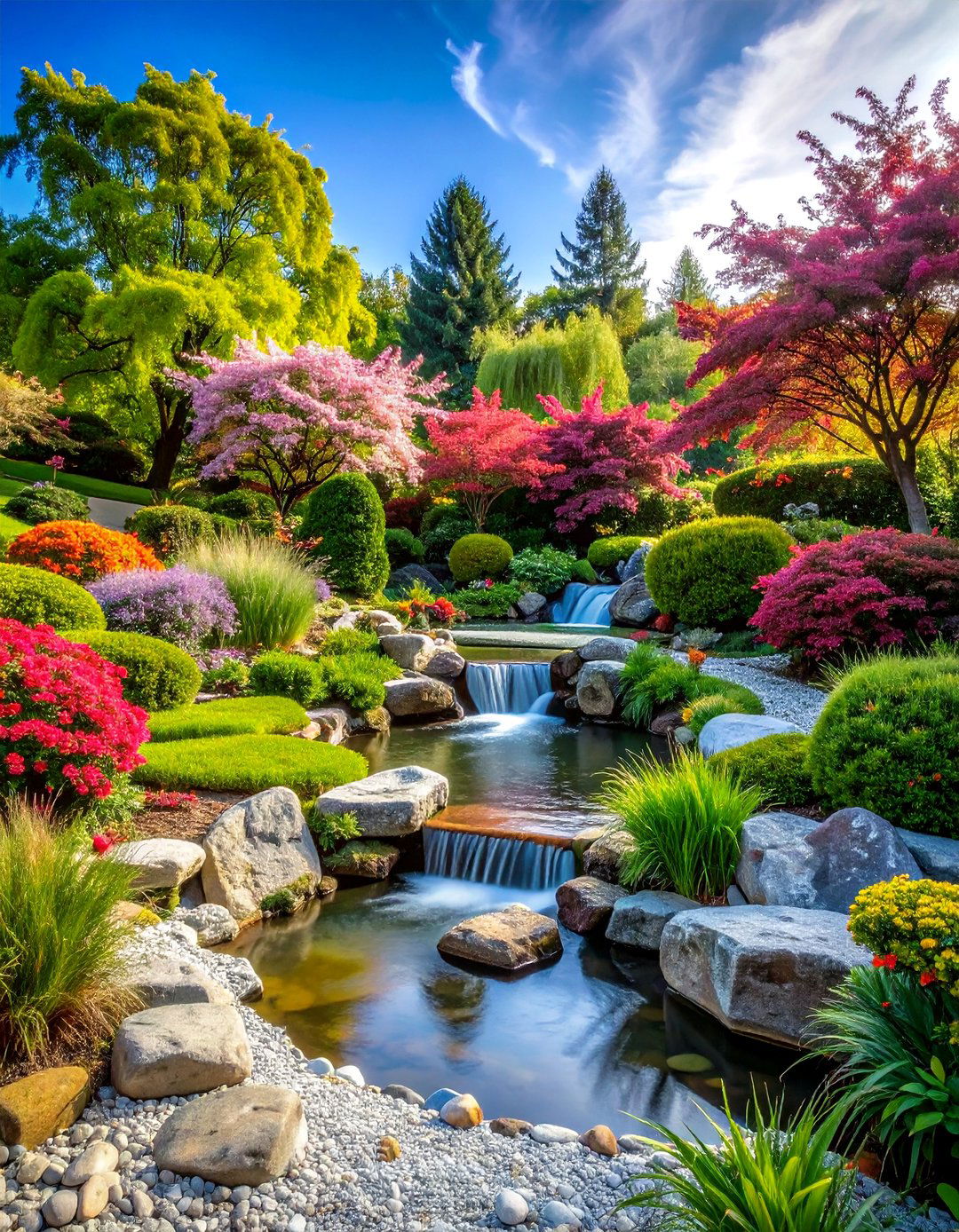
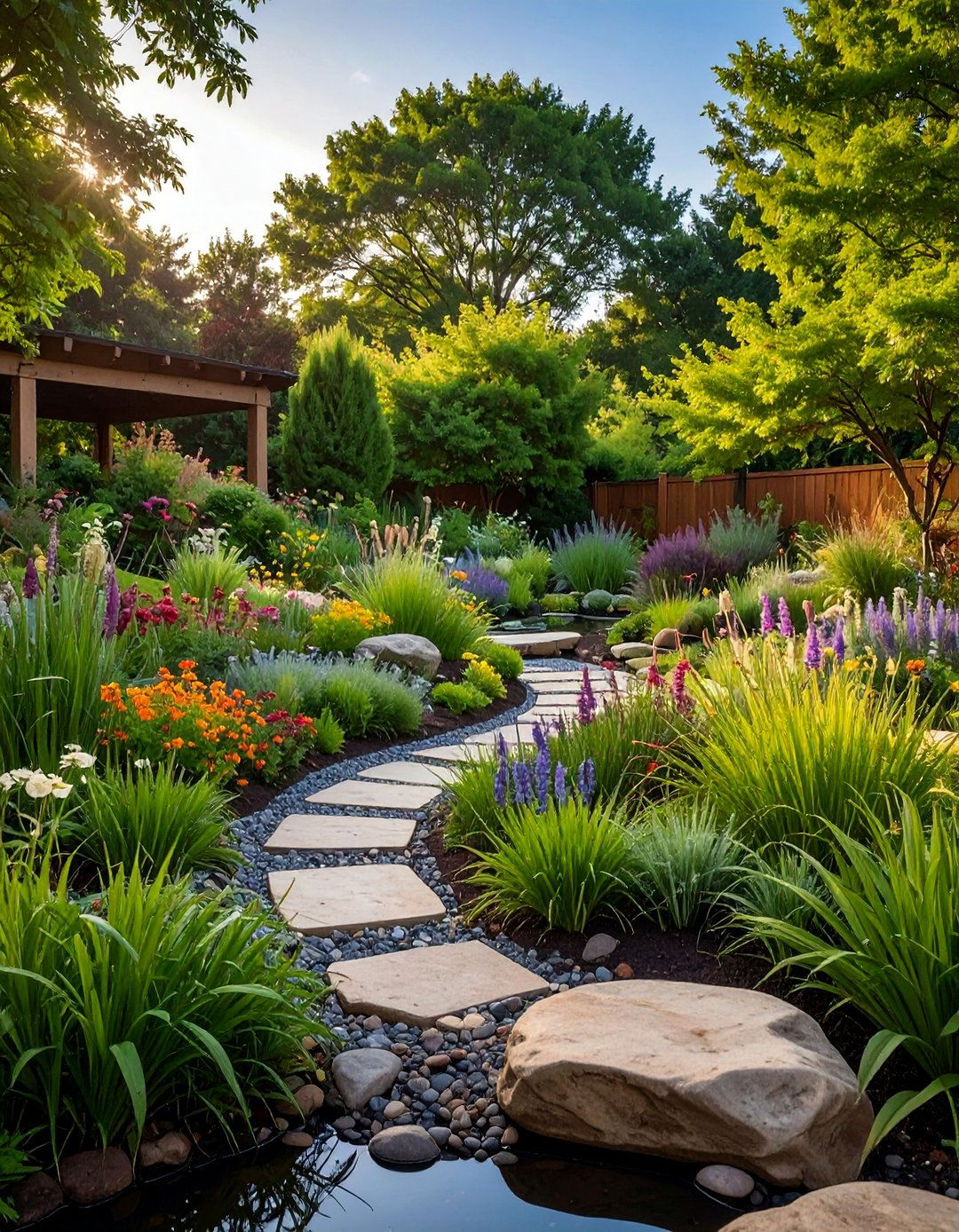


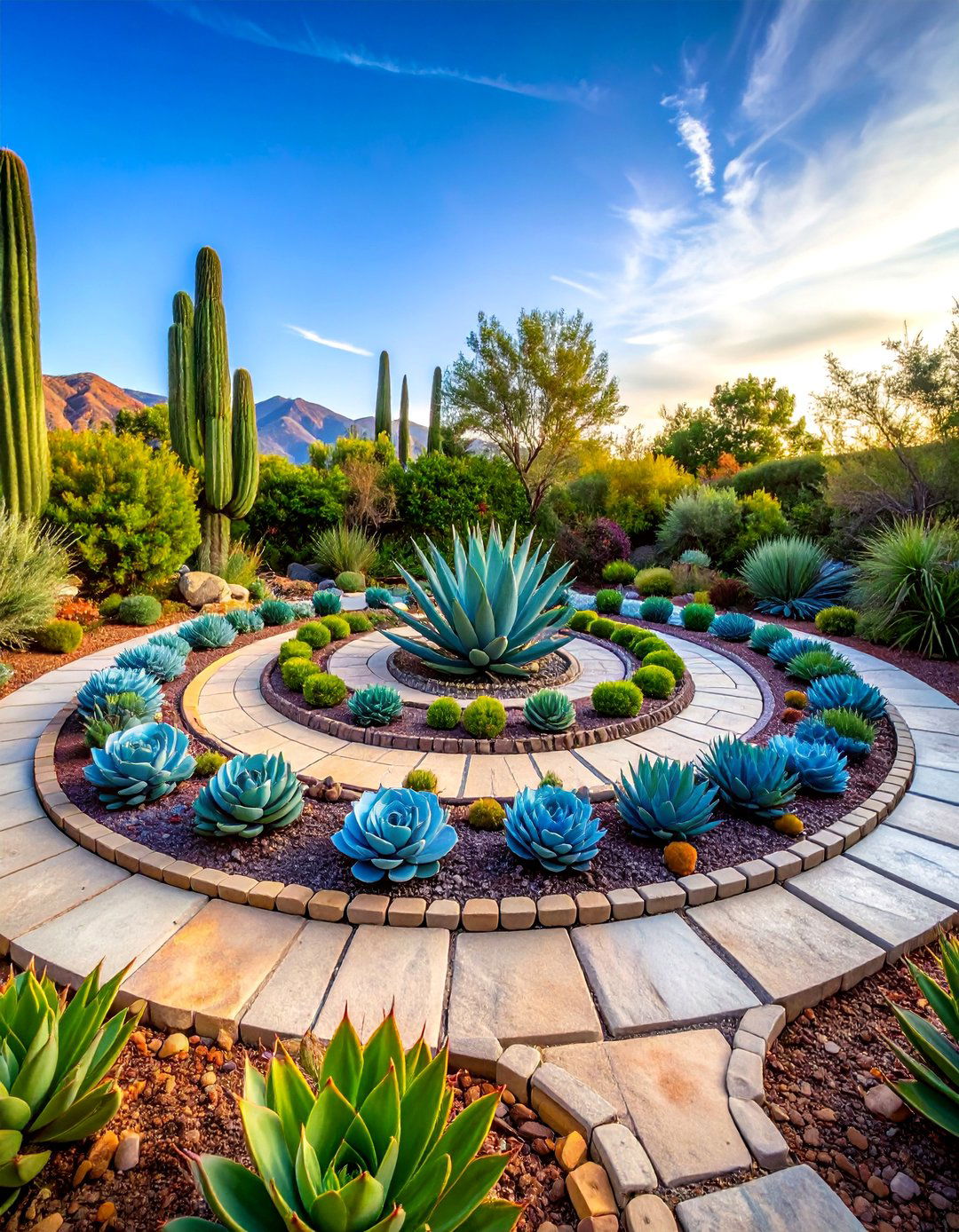
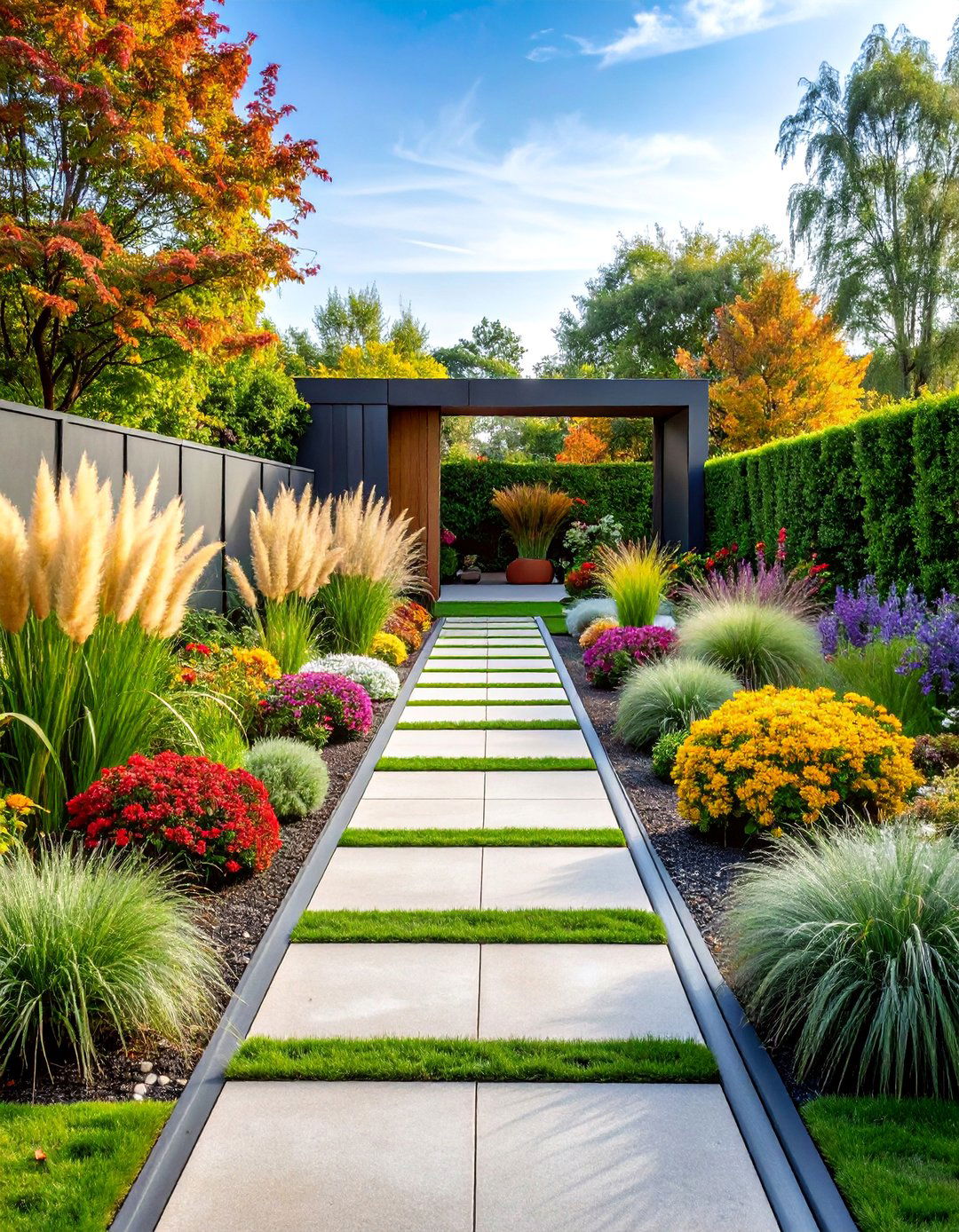

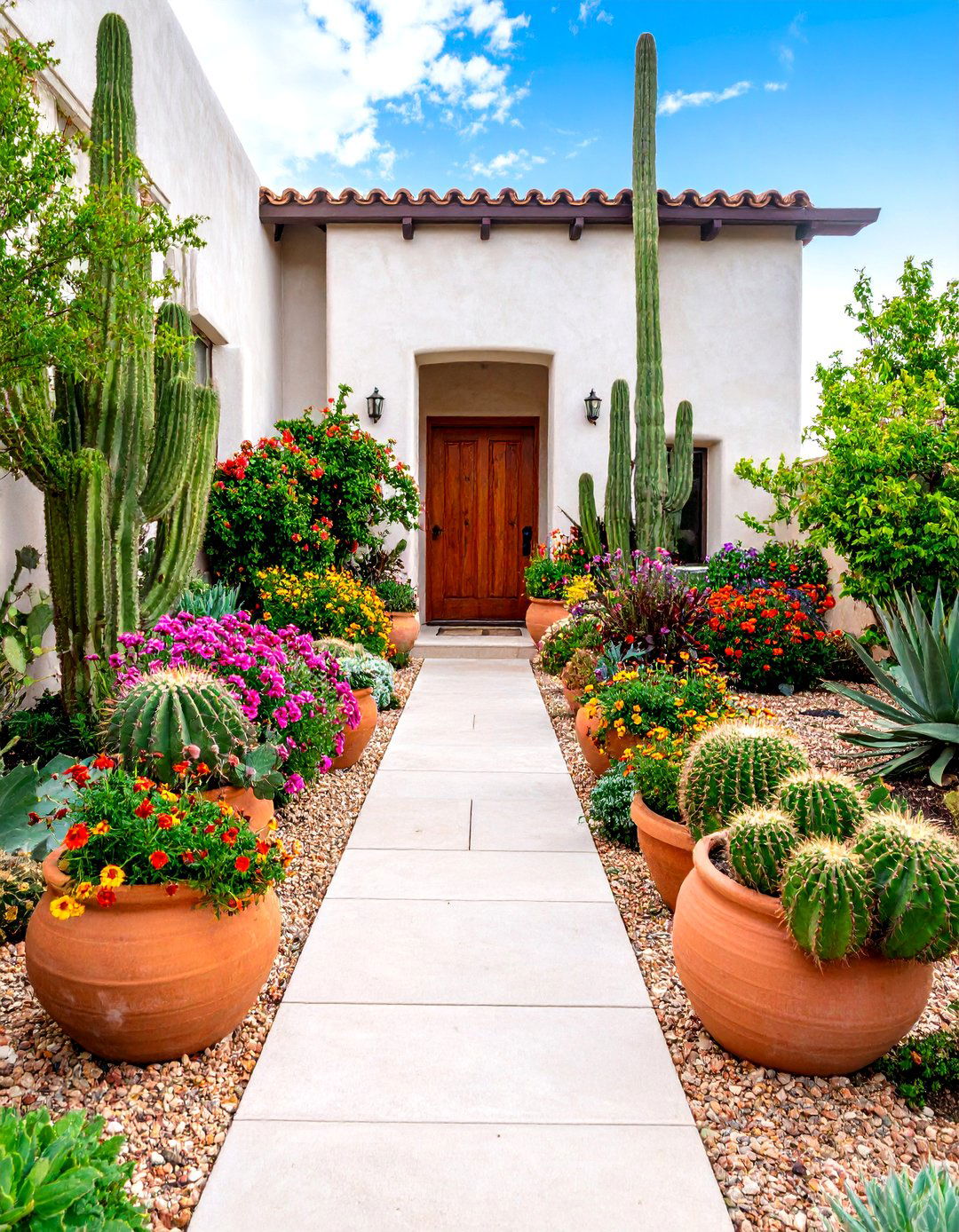

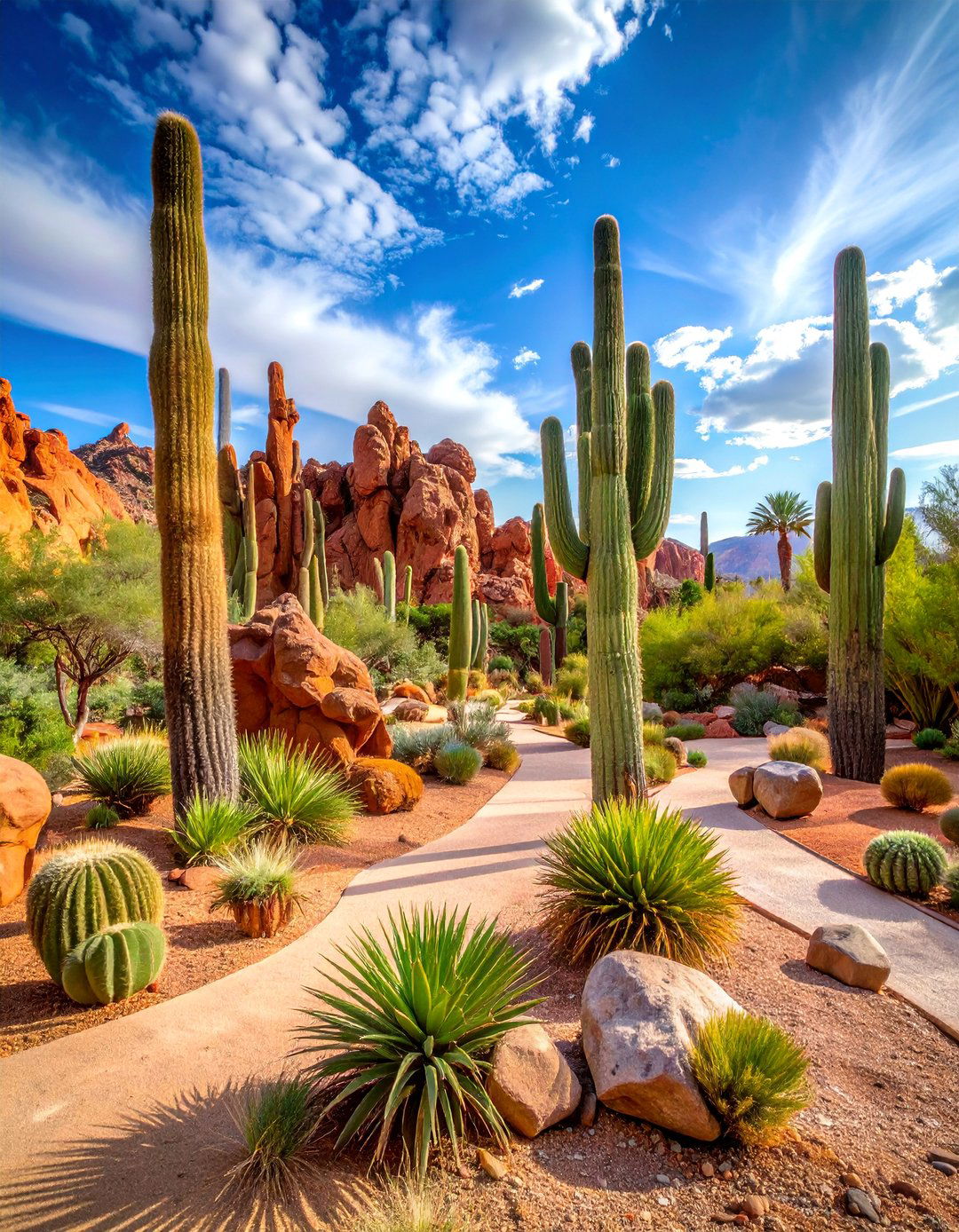

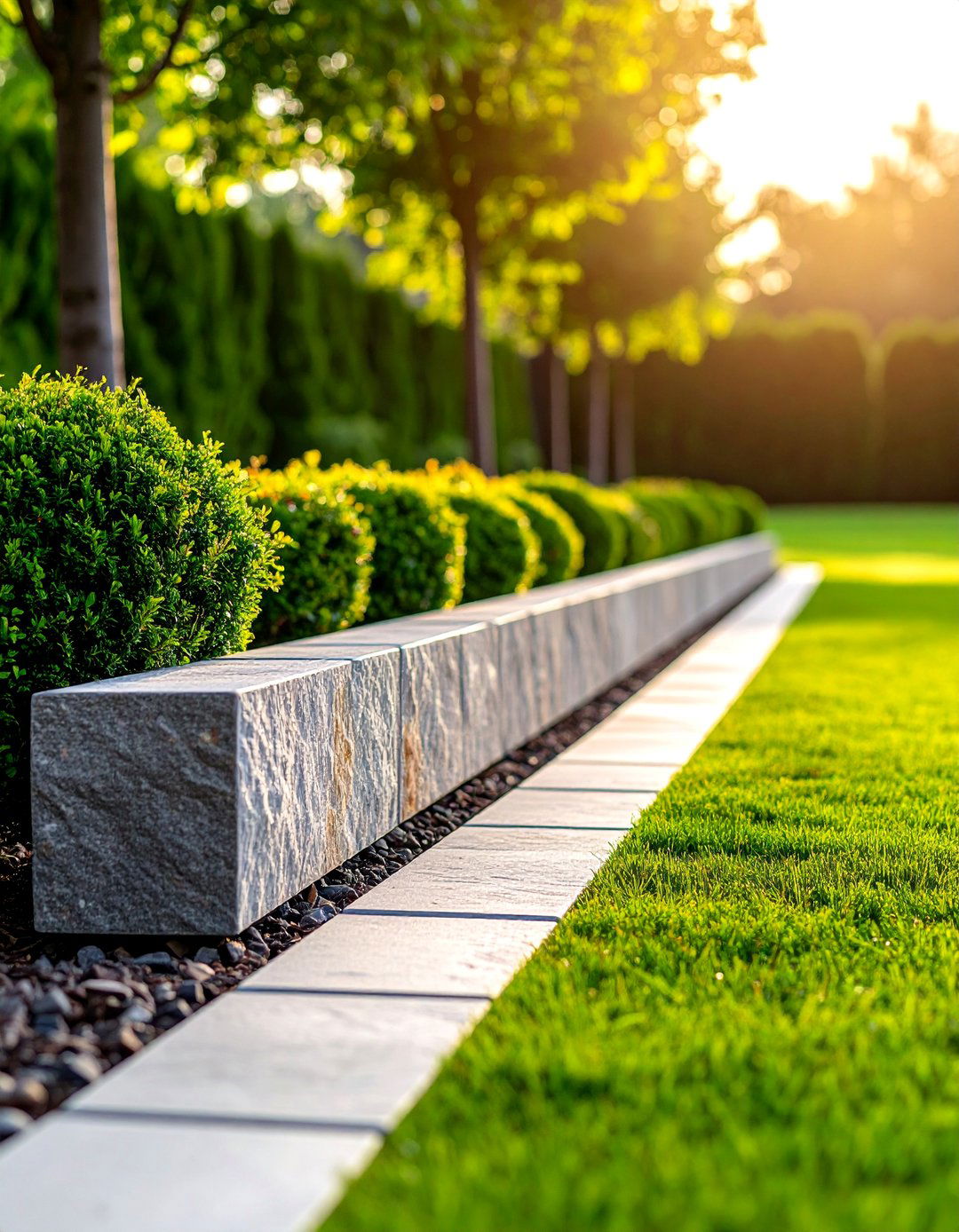

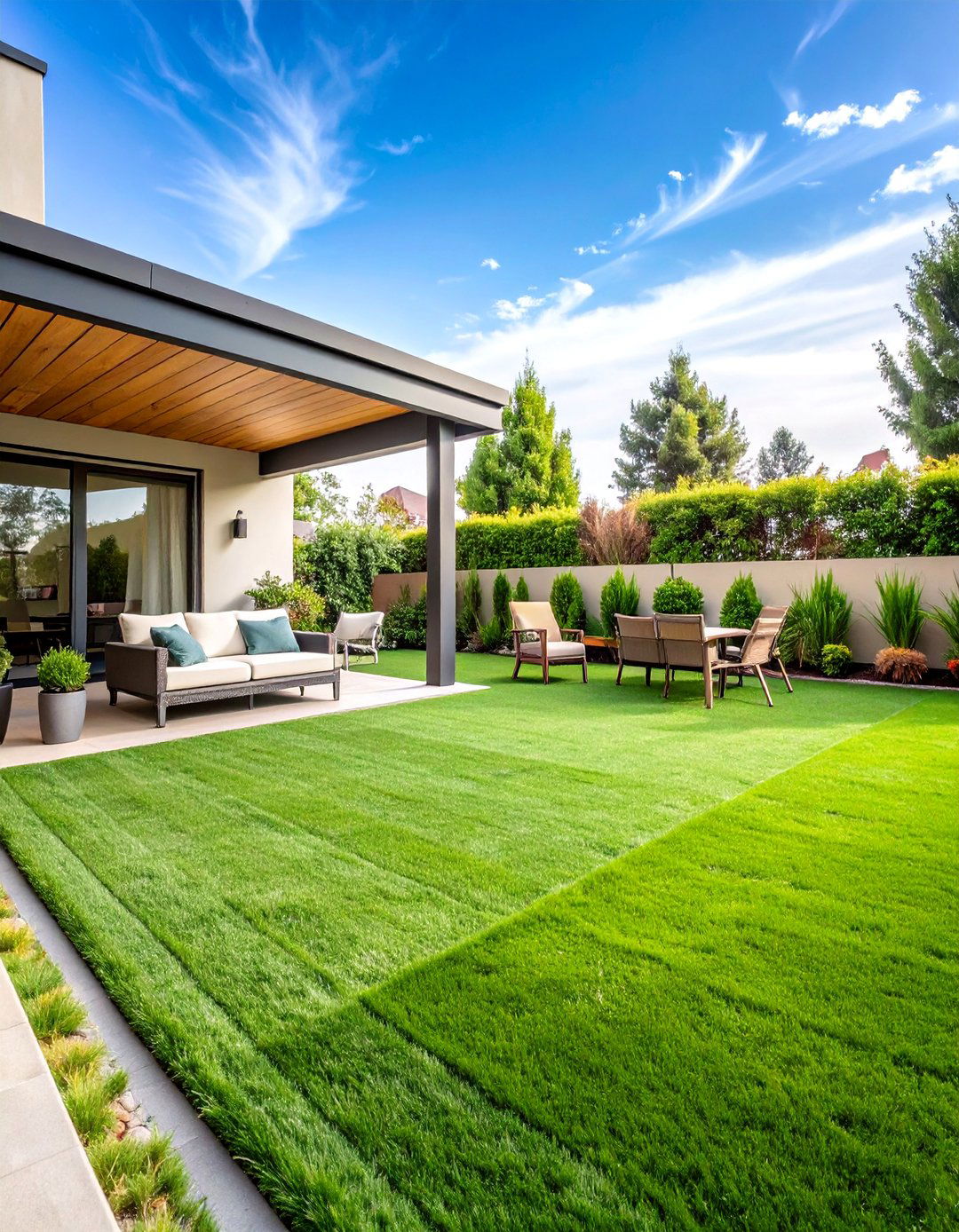

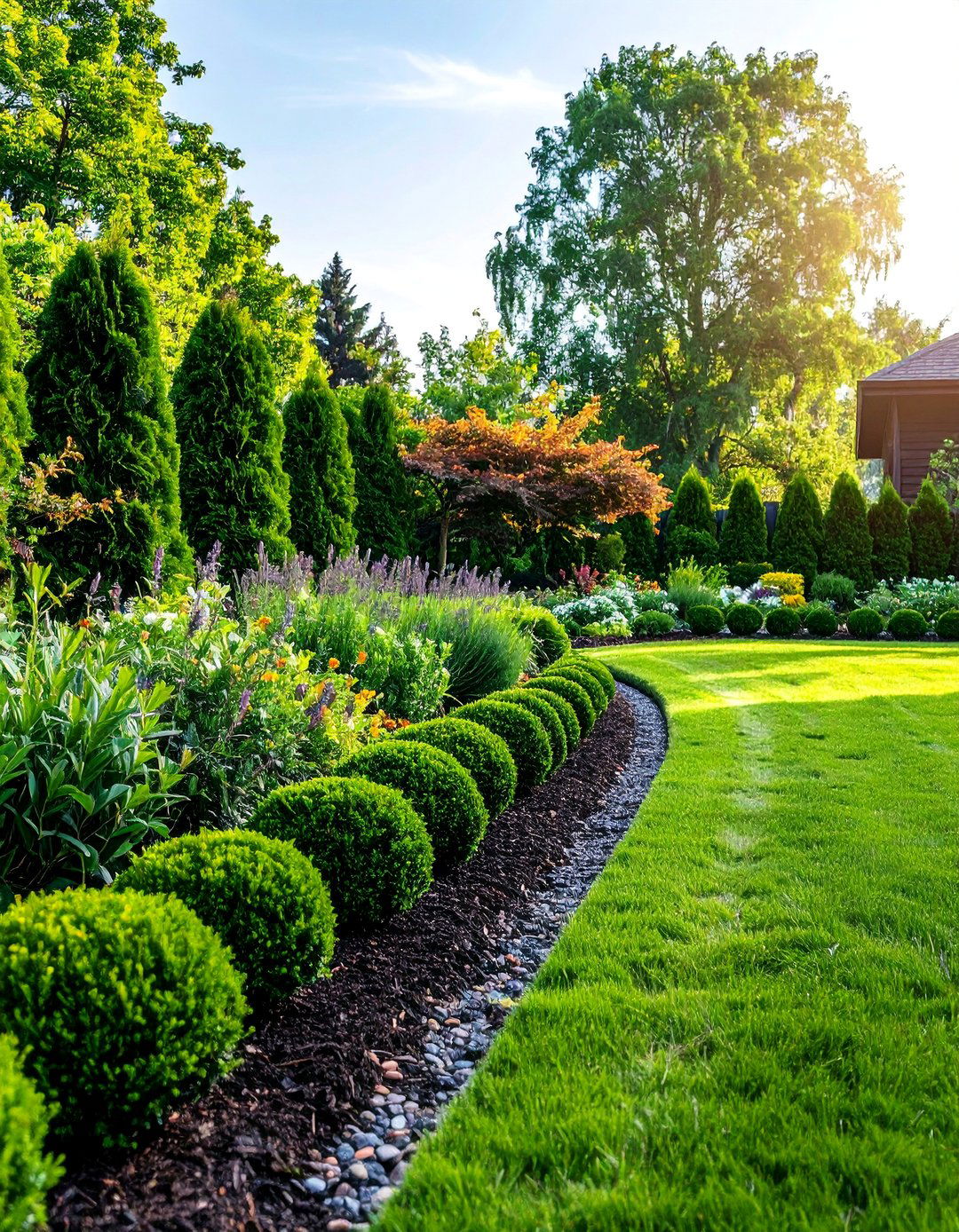
Leave a Reply